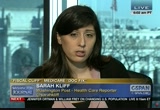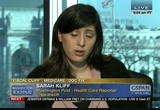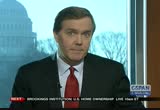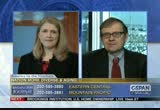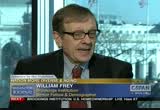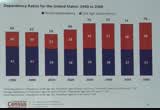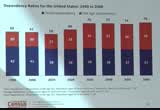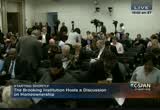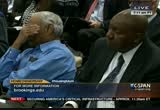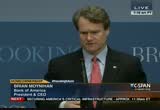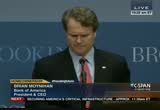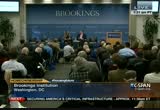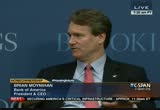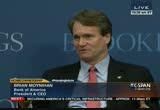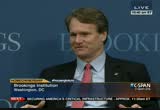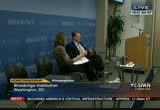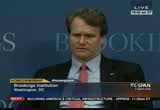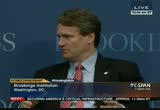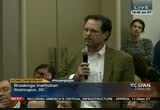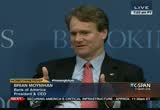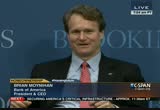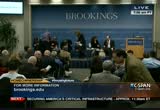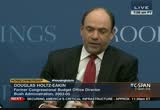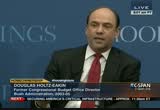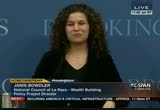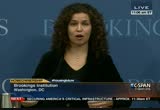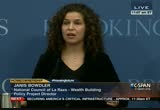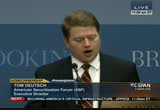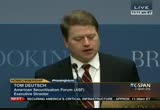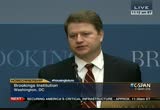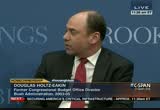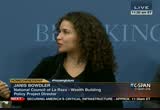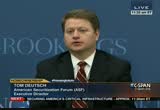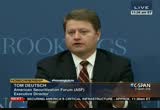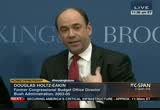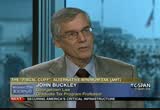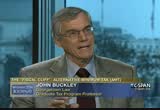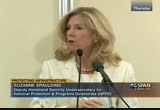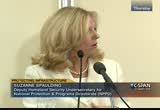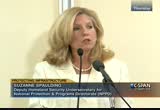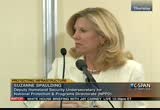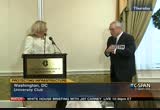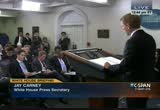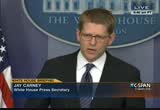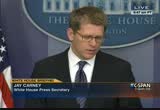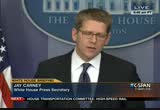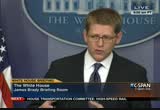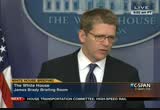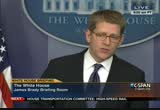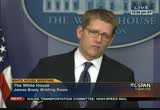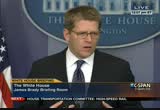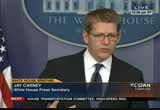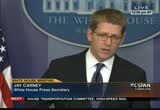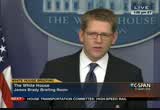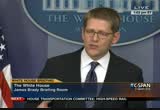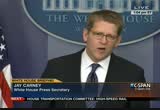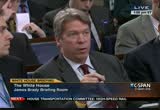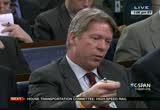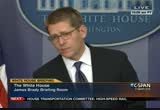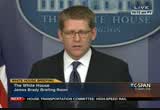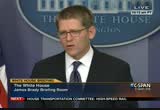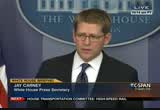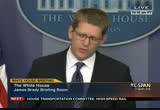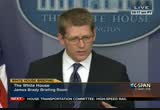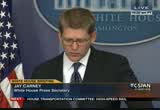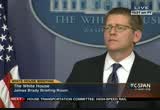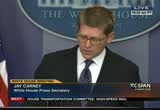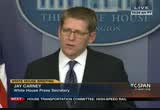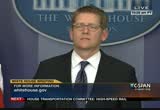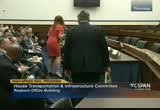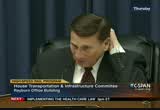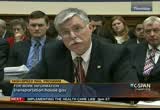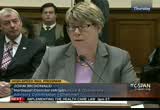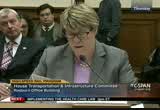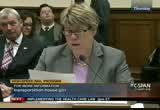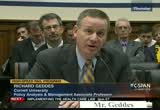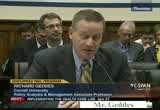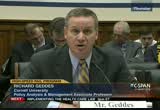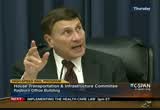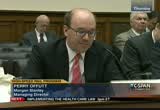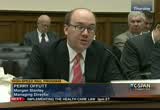tv Public Affairs CSPAN December 14, 2012 9:00am-2:00pm EST
9:00 am
technology are driving this increase in costs. you look at the past few years of health care spending, the actual volume of health care has either gone down a little bit or has remained constant where people are going to the doctor a lot more. the prices are growing faster than the rate of that is driven by new technology that is coming on the market. the obama administration is taking some steps. there is the accountable care organizations. the idea is to move away from a we have right now where doctors get a set amount for each service they provide.
9:01 am
these organizations move to pay people for quality instead of quantity. the obama administration will give a hospital a set amount of money for caring for the patients. then the doctor has to strategize so they don't have to go into the red. they are hoping the model will drive down costs and get rid of the incentive or just that -- we're at the start of that program. host: brian from massachusetts with sarah kliff. caller: a caller talked about marriage practitioners and there is a lot of them. they pretty much have a lot of
9:02 am
schools are graduating many nurse practitioners and physician's assistants. there is a cap on the amount of doctors they can create. nurse practitioners have two years of crammed education. i think they are good providers. we cannot assume that a nurse practitioner or physician's assistant are going to be as good as medical doctors. guest: that is a criticism that a lot of people raise. are these people going to be as good as doctors? in certain spaces, they provide justice high-quality of care as doctors.
9:03 am
a lot of people expect that nurse practitioners provide basic functions of madison, things that been done in a standardized way. doctors have more training. host: this goes into the overall debate in terms of the doc fix. the national debt was in excess of $16.3 trillion. guest: health care is a huge part of it. it is pretty much our health care programs and i think that is why we are debating that in washington and that those programs are a huge part of the conversation. host: democrats are saying it is
9:04 am
off the table. guest: there are other changes they might be ok with. means testing in medicare which results in those who earn more pay more for their medicare premium. that is one proposal that democrats have begun more comfortable with. there are other changes they might be more comfortable with. host: ron has this suggestion from our twitter page. guest: that is a term we heard. when the cut health care, someone will be bearing the cut.t of that kin that is similar to the concept of those care organizations.
9:05 am
they also include quality metrics as part of the contract, where they look at people's outcomes. one way to prevent against the u.s. skimping on care. host: this from sasha -- guest: that is one proposal that gets floated by democrats. medicare part d bargains for drugs. i do not know -- i do not think it would be a cure all, the one proposal that would fix everything. democrats think it would reduce
9:06 am
the cost of medicare. host: is there a plan b? guest: we have seen them as the january 1 deadline before and get 30-day extensions. at some point they were working without an extension. medicare told doctors to hold off on submitting your claims for a little bit. that is a situation we have ended up in before. if we're talking months, we're talking about big pay cuts for medicare doctors. that would be uncharted territory. host: joe from arizona on the
9:07 am
republican line. caller: good morning. if we look at it logically, sarah is on the right track. we have become a society with honesty as a technicality. you can get more money but you break the law. our society -- you need to stop your people on the show, politicians and say, i asked you a question and you didn't answer it. this is why the doctors in medicare can get away with it. grover norquist was on the other day. this guy is affecting the whole
9:08 am
country. let's be logical and real. you're cheating the system. honestly with a technicality has to stop the way walter cronkite used to do woit. "i asked you a question and that wasn't the answer." stand up to people. "we're the first line of defense." i applied all of you for as much as you try. you have to hold their feet to the fire. i'm so sick of the split amongst this country. hold them to the fire.
9:09 am
host: thank you for the call. we try to do that. keep calling in and sending those tweets and e-mails and keep us on our toes. guest: why isn't anyone doing anything? health and human services runt fraud prevention and fraud detection. that has been ramped up by the affordable care act to target those people. the government estimates they have recovered about 4 per $1 billion in medicare fraud -- $4.1 billion. host: this is from one of our
9:10 am
viewers. guest: that is the hope from the obama administration. reimbursements cannot keep going up and up and up. health care is about a fifth of the entire economy. if you give people a budget to work in, they will change the way they work. they have to figure out a new way to do business. host: cedric from texas, good morning. welcome to the program. caller: i'm a physician and i follow your journalism. the fewably one of
9:11 am
physicians that agrees with eliminating -- i want to eliminate all government plans. i would be willing to take nothing. i believe the only way to fix this is by setting up a free market. prices meet demand. none of these things meet the demands of the people. with regards to seniors, they talk about how much insurance companies are taking. when they convert from a plan to medicare and how there are hoops. their lifestyle decisions --
9:12 am
they are lifestyle decisions. president obama is trying to give bundled payments for health care results. a large portion of the population knows they are supposed to eat well and not to smoke. they need their hips replaced the day they turn 65. they know what they need to do. it is not something simple like putting through a scanner and getting the answer right away. they are not interested. you end up living a long, healthy life. you can still get everything at the expense and burden of the younger generations.
9:13 am
i've been a physician for 10 years. i just turned 40. i'm not the primary care physician. .'m an anesthesiologist host: we will get a response. guest: that is an important point. lifestyle decisions are driving spending. the health-care law allows employers to vary their premiums. by taking a smoking cessation class or going to a primary-care doctor like you should be? there is only so much that a health plan can do to affect the
9:14 am
lifestyle choices that its members are making. you do see some investment in the health care law. host: janet on the republican line. caller: good morning. i am in massachusetts which is probably the future of where we are going as a nation. the health-care part has grown to over half of the budget. i took a look at my personal situation. my health insurance costs were taking up 25% of my income. i read to the policies. poor and low-income people are being required to pay a premium . when
9:15 am
it elected its services they get -- when you look at the services they get, what they are required to pay for is air. there is no benefit there. these programs are taking money t.om the poor and keeping i called around to the practices in my county. i found that if you were on any of the subsidized programs, you were told that the primary care physicians books from booking initial intake annual physicals were all booked up for the next year and that's the next three months of appointment books would open up and call back
9:16 am
then. guest: these are interesting points you raised about massachusetts. massachusetts was the model for national health care law. they have the top medical institutions in the country, places like harvard and massachusetts general. they have the highest insurance premiums in the nation. increasing insurance coverage, and they have done that. 90% of the residents are insured -- 98% of the residence are insured. host: will this be resolved before january 1? guest: i think a lot of people
9:17 am
want to get solved by january 1st but we're still a few weeks away. host: sarah kliff covers health care for "the washington post." thank you for joining us. we take a look at america by the numbers and what america looks like by the year 2016. jennifer ortman and william frey here to talk about america by the numbers. we are back in a moment.
9:18 am
[video clip] >> punch me, straggle mae, take things from me. >> we're starting to see people coming out and talk about their experiences of this phenomenon that some have experienced and had no words for other than growing up. people were starting to stand back and say, "this is not a no part of growing up." there was a moment where there
9:19 am
is a possibility for change. we decided to start the film out of that feeling that voices were bubbling up to the surface it to say, this is not something we can accept in our culture. >> she has gathered essays and stories together in "bully." like us on facebook. >> the white house was very controversial, as most things in america were. l'enfant designed washington city. there was a competition and he submitted the design for a palace. americans were not having a palace. it was not particularly awe- inspiring. in fact, in 1821, a european
9:20 am
diplomat told the congress that as neither large nor awe- inspiring. but the answer the congressman gave said the building served its purpose. if it were larger and more elegant, perhaps some president would be inclined to become its permanent resident. >> former "new york times"" photo critic vicki goldberg has gathered a few of her favorite white house photos in "the white house, the president's home in photographs in history." watch sunday evening at 7:30 eastern and pacific on c- span3's "american history tv." >> "washington journal" continues. we're glad to have back william frey from the brookings institution. and do jennifer ortman. population will be in excess of
9:21 am
400 million people in the u.s. what is going to change? guest: the nation is projected to grow at a slower pace over the next 38 years. the population will continue to age. that the nation is projected to become more diverse in growth, minority population, and decrease in population. host: look at these numbers. 420 million -- how do face the demand of that growing population? education, health care? guest: that is a perfect
9:22 am
question for bill. guest: it really is a slower growth than we have been used to for a long time. about a 34% growth rate over those 48 years. we have been going on about 10% a decade. we'll get used to slower growth with a new minority population filling in at the bottom of the slow-growing part of the age distribution. and older population that is growing rapidly. we have to deal more with minority integration and social inequality and issues with the new americans. host: so aging growing slowly and more diverse.
9:23 am
we have divided our phone lines by region. host: you can also join us honor twitter page. i want to go back to this graph. under the age of 18, you can see a drop. then an increase of those 65 and older. can you touch on these numbers? guest: fertility rates, mortality rates, and the international migration. what we're seeing when it will look at the population and will
9:24 am
look to these broad age groups, and then the population 65 years and older, those retirees, we're projecting lower rates of fertility overtime. that's one reason the group under 18 years old is not growing. the population 65 years and older, we project some improvement in terms of mortality, life expectancy going up. people to live to older ages. we're seeing the baby boom ohorts moving into the 65
9:25 am
years and older population. host: white, black, and hispanic of any race. guest: we're comparing what our projections show the distribution of the population to be in 2012 compared to the projections for 2060. the white population has the majority and the largest in terms of share of the majority. 69% in 2060. if we focus on the non-his panic population, that
9:26 am
population is projected to decrease its share of the overall population as well down to around 43%, becoming a minority in these projections. guest: i think what is happening here is the fast-growing part of the population -- an artist more than double their population size over this 40-year period. the white population after 2024 starts to decline. we see this shift with the lower white share because of the growth of the minority population, which will continue from fertility and immigration. the white population will have a natural decrease, more deaths
9:27 am
than births. it is growing younger and minorities and declining older whites as we get to the last part of this decade. host: that puts this in perspective. by 2043, the minority population projected to be the majority. guest: that is correct. they are projected to reach the the 50% and cross the mark in 2043. guest: we are at a pivot point. guest: by 2018, the child
9:28 am
population will turn it into a minority white because it is the younger part of the age distribution. we will become majority minority for different age groups, the under 18 population and the 18 to 29 population and keep on going. the older population stays majority white for the entire span of the projection period. i think it makes an important difference for lots of then use of our society. the child population is leading the way. we see that in the schools and into the housing market and middle ages. we concede the ages coming and
9:29 am
people should pay attention to that. host: once agreement is reached on the fiscal cliff, the next item will be immigration reform. how do these numbers went into the debate -- weigh into the debate? guest: they made good assumptions about what the projections are. that is the biggest question mark in terms of what will happen with the growth of the population. if we have increases or decreases in immigration overtime and what the countries of origin will be. in the last five years, immigration has really tanked. there has been some emigration
9:30 am
back to mexico. i did not expect that to continue over time. the real issue -- the kind of long-term economic growth for the united states will be very much shaped by the immigration policy and the nature of the kinds of preferences we give to different immigrants that are coming in. i think we'll have a large discussion about this once we get over these political hurdles. host: did you want to weigh in? guest: potential future of migrants coming into the united states.
9:31 am
our projections are based on past trends. we make some projections about how many believe thing. it is lower in this theory. we have projected a much higher level of international migration. led to less rise in that assumption to have that much lower level overall. host: explain this graph and how you get to these numbers by the year 2060. guest: this answers the question of how we make the projections. they are made based on assumptions of future rates of
9:32 am
tality.ty, mor we start with the starting population. we are using the 2010 census. we start by aging the population forward. each year the population is when you're older. then we had in the number of projected burst and immigrants -- projected births and immigrants. we subtract the number of deaths. host: jennifer ortman from the u.s. census bureau and william frey from the brookings institution. what will this country look like? john is on the phone from
9:33 am
florida. good morning. caller: i would like to make a couple comments. slavery, this is chasing cheap labor. this world trade nonsense. this is chasing cheap labor -- business chasing cheap labor. guest: he goes back to the era of slavery. i think that is part of the past. it is important that we treat immigrants fairly, even if they are not yet citizens. in terms of their general
9:34 am
overall quality of life here. that has gotten better over the years. host: kelvin from portland, oregon. caller: good morning. thank you for hosting this show. looking at the census for the future -- hello? host: we can hear you. caller: i am a fan that enjoys the various topics that you show. i agree with the folks debtor showing demographic data -- that are showing demographic data. my question to the guests this
9:35 am
morning has to do with the impact of a single member district verses running at large and the correlation to how that will impact the voting patterns for the future. that's my question. guest: i have to punt on that specific question. we saw that in the presidential election. never saw a so much attention given to demographics. that had a lot to do with the outcome. it may have some impact and it is part of the voting rights act. that is being relooked at again.
9:36 am
host: to find a baby boomer -- define a baby boomer. those baby boomers at are beyond the age of retirement. how many are moving into retirement age in the next five or 10 years? guest: i don't have that number with me. host: but it is growing. guest: it is growing. this is the projected age structure of the population. each park or descends the population at a given age -- each bar describes the
9:37 am
population at a given age. i have highlighted the baby boomers in red. they have been driving the trends we see over time. we project they will continue to be an important driver. as to look from 2012 to 2035, we see the baby boomers moving into the oldest ages of the population. by 2035 there will be between the ages of 71 and 81. in 2060, 2.4 million baby boomers left. caller: good morning. how are you? i wanted to thank c-span.
9:38 am
i like the topics you show on the air. at 2043, youking are going into the second generation. we all come from immigrants. i'm a third generation american. my family came from italy. just because i'm white, we do not look at those numbers the way. the immigrants here today or 20 or 30 years ago, their children in 30 years will have children. you are looking at a third generation americans. i don't understand the numbers of what you are looking at at
9:39 am
2043. guest: that is an important question as to how we classify people. we have a ready rate of enter ethnic an interracial marriage in the united states. it is fairly high for asians and for hispanics. my prediction is that 20 years or so outcome these kinds of categories will be pretty much obsolete or take a different form. i think that is what the caller is getting at. what kind of race or ethnicity would call them and so forth? things blur a labatt more than
9:40 am
we see -- a little more. host: we are looking at america by the numbers. william frey is a senior fellow at the brookings institution. manuel from buffalo, new york. caller: good morning. this is interesting stuff. we saw the 2010 census. we saw the census missed a lot minorities accounted a lot of whites twice. how does that factor into your projections? host: we will get a response. guest: each time we take a
9:41 am
census, there is a staff at the census bureau that evaluates the census. coverage is one of those things. i don't have the numbers to speak to what the findings were in evaluating the census. we used the 2010 census as the base population. host: we have been talking about fiscal cliff issues and entitlement programs. guest: that is a real $64,000 question. i cannot come up with an answer . people would like to know the ad it. if i h that 65 and over population will
9:42 am
grow, 30 million after people will become 65 and older between now and then. 85 and older population will more than triple. by then, the population will be top heavy. it will not be as big at the bottom. who pays into it? those are issues that are partly democratic. part is involved with the cost of health care and how we deal with that. those are the important issues we have to deal with. host: laura, welcome to "washington journal."
9:43 am
caller: happy holidays to everybody. i am doing research on poverty. the u.s. census bureau is one of the best places to go. poverty is related to the number one group -- marriage is a healthy boundaries that we should be having the government encouraged because it drops the probability of child poverty by 80%. that is a staggering statistic. those homes with absent fathers also have higher incidence of criminal behavior and higher incidence of school dropout
9:44 am
rates, drug and alcohol abuse and emotional problems. it is time with all of these statistics that we get to the policy of encouraging that. you would think this president would have a government response to that. host: your final point? caller: we talk about the racial component. blacks account for 13% of the population. they will have higher poverty statistics. there is much higher of black as a percentage of the population. host: laura from pennsylvania, thanks. guest: there are lots of
9:45 am
perspectives here in washington about how to deal with this important issue of high levels of poverty. 20% of the population is a married couple with child household and most of the non- farm households are white. the issue of race is not necessarily as central, as the caller says. married couples are among those that are the most well off in the country. there are a lot of folks that need a lot social support. i do not want to get into the middle of this important debate.
9:46 am
host: let me put some other headlines on the table. 400 million people will be living in this country. guest: i brought this figure to give this another way of looking at what the changes are in the age structure. when we look at the growth of the population 65 years and over, we can see back to 1990 when the population was around 30 million. we see that red line start to increase sharply between 2012 up to the 2030's. it will level off after the baby boomers enter into that age
9:47 am
group. will that lead to population being larger? host: and a political question for you. tost: i think there's a lot it. these projections are not done at the state level. a large hispanic population. it is a matter of how the racial groups votes. they will have many more hispanic voters. host: with bill frey and jennifer ortman. jimmy is next from georgia. caller: good morning.
9:48 am
i want to talk about a growing number of people going on medicare and a growing number of people on medicaid and all that. if they take the refugees and all people coming in here, when net be the simplest thing to do -- when that be the simplest thing to do? all the focus is -- they don't talk about nothing about their stuff. is everybody on track here? host: ok. tricare. guest: i am not familiar with that term. host: talk about bending the curve with health care cost.
9:49 am
what kind of pressure does is put on washington to come up with a solution with regard to a budget deal? guest: well, to the one thing that would help a lot of decision makers in washington understand where we're going in the future is to look at some of these projections that show the growing part of our labor force over the next 18 years will be almost totally from hispanics, asians, and african-americans. there'll be a decline in the labor force of 14 million whites. we need to make sure these young people moving into the workforce are prepared to have good jobs and to contribute to good middle class lifestyle and to contribute to the social security program and to the medicare program.
9:50 am
we think about the fiscal cliff and intolerance for the elderly. it is important to get resources whether it is medicare or support for education and make sure these young people are taken care of. those are tough decisions to make. people should look to these projections to see where we will beat next 20 years. graph.this latest dr guest: bill was talking about looking at changes in the structure. this is another tool we have. bear with me just a moment.
9:51 am
it's the information on this. this is the ratio of dependence that are typically not working to the size of the working age population. the basic thing when you look at these numbers is the larger the number, the more potential dependents. and the reverse is also true. the blue columns represent the youth dependency. how many children under the age of 18 relative to the working population. they continue to decrease over time. there will be about 37 children for every 100 in the working
9:52 am
ages. the red columns represent old age dependency bolted to the working age population. the ratios have been stable in recent years but are projected to be increasing, reaching the age of 39 in 2016. 100 'll be a 39 for every working ages. host: there are 30 workers for every 21 -- guest: look at the number 38, 38 children for every 100 workers. a one-to-re almost to
9:53 am
one ratio. guest: that is what these numbers show. we project there to be 76 dependents from oldest to youngest. host: we will go to van. welcome. caller: i will call myself an african-american/black. oroy.kow oknow our hist we are in one small group by ourselves. the census, it wanted to compare us to hispanics. i do not know what a hispanic is. is it from mexico? does the name have to sound hispanic?
9:54 am
there is that what you can compare hispanics to african- americans and say they are growing so much. of course we are not growing. people from haiti or jamaica call themselves other or something else. can you explain that to me? guest: there is public and official name and it is anyone who says they are hispanic, and as if someone says they are african-american or black. typically people that come from a country where spanish language is typically spoken. the caller is right. it is a fairly broad umbrella. it takes into account people's
9:55 am
heritage or the language they have spoken. it is growing. the african-american population is also grown somewhat from immigrants but not as dramatically. it is a little bit a squishy term. host: you go through all these numbers and projections, what surprises you the most? guest: the finding i found most interesting is we're seeing the pace of population growth is much lower than what we had projected four years ago and i found that striking to see that in just watch for years we would see such a drop in projected growth rates. host: is the growth in the south
9:56 am
and west decreasing? guest: we are not produced state-level projections and we do not have a recent series i could refer to. host: sounds like it upcoming program. good morning with jennifer ortman and william frey. caller: hi. how are you doing today? i have a daughter that teaches school and she is in south carolina. i have had experience with family members that teach in the county i am in. i have family that is involved in the school system up in jackson county which is in georgia. the impact is that immigrant children that are coming into
9:57 am
that do notystems speak english and there are multiples, not just hispanics. they are from all over the country all over the world coming in. these children -- the school systems are not getting resources from any of outside source to help educate these kids to speak english. the school system's do not have any bilingual teachers in the schools to help them. they don't have the funding to help them teach these kids. host: thank you for the call. guest: that is an important consideration with respect to
9:58 am
new americans coming into the country. those kids have an opportunity to succeed in school. there are programs that require schools to have people proficient in teaching english language learners but the resources are not always there. looking at these numbers, it is important those schools have those resources so those kids can succeed. host: albert is on the phone. caller: good morning. 8 lot based on the 1900's and in 1940's, the ethnics question comes into play. the indian reservation deals with these roles, census roles.
9:59 am
would be a change in this country for a deal that focuses more on the native american indians? they use this inaccurate estimate as to who people think their ethnic is in order to enroll? it's kind of like a freedom question. most native american indians cannot prove they are in americans based on the census. guest: people are asked to report their race and their hispanic origin and allow them to self report that information. host: you have gone through these numbers. you have a snapshot about where we will be.
10:00 am
advice would you give? guest: the census bureau is here. our mission is to provide these data to update the productions -- projections every few years. guest: this is a changing landscape. host: what we do tell washington -- what would you tell guest: i would say the older population is going to decline and in 2020 the majority of school-aged kids will be
10:01 am
something over than whites in the united states, and as the caller said, there's a real need for people to come in and speak english language learning, all those sorts of resources to help the young children succeed. looking at these projections makes it ape bundn'tly clear. host: with the u.s. census bureau to take a look as we do on fridays at america by the numbers. >> quick note about washington today. the house and senate are in recess today and back next week. possibility of votes into next weekend as we heard from eric kanter, the speaker and president met yesterday and no new talks scheduled publicly. we will follow the fiscal cliff story on c-span. coming up next, we're going to
10:02 am
take you live at the brookings institution, a look at u.s. homeownership, a panel that is about to begin including bank of america c.e.o. and douglas aiken who joined us last weekend on "washington journal" and another who covers news for cnbc. what to look for in the future. a reminder we are back at 7:00 a.m. eastern time check out our schedule information at espn.org and over the weekend on espn2 book tv programming and on c-span three our american history programming. thank you for being with us this friday. enjoy your week. [captioning performed by
10:04 am
>> and this morning here on c-span, we're live at the brookings institution for a discussion with brian monaghan followed bay discussion on homeownership including the costs and the world of lenders, investors and government policies in chiefing that goal. some consumer news this morning from the labor department. they are saying a steep fall in gas price sincere pushing down a measure of prices, the seasonly adjusted consumer price index dropped after a 1% increase the previous month.
10:05 am
>> good morning. i'm vice president and co-director of the economic study program at brookings, i'm pleased to introduce our keynote speaker, bank of america president and c.e.o., brian moynihan. he has been crowe of one of the largest banking institutions and serves many different audiences. consumers and businesses of all sizes as well as investors with a full range of banking, investment ands a credit and
10:06 am
products and services. if you are thinking you see them everywhere, you're correct. they bank one out of every two households. i've got on the know brian in an advisory council. s the a council of community developers and wonky types hike me that offer tips on how it can best help underserved americans. brian grew up the sixth of nine children and in high school he had a job of as bus boy and dug ditches and worked at a plant that made industrial magnets. he later attended brown university which is something we have in common and played rugby well according to some of my rugby-playing friends and met his wife there. he is a lawyer by trade with a law degree from notre dame and started out in the general
10:07 am
counsel's office in 1993 which then merged with bank of america in 2004 and was eventually elevated to general council in 2008. when bank of america bought merrill lynch as it was teetering on the edge of the financial crisis he was named c.e.o. of the investment firm then c.e.o. of the bank. so brian became c.e.o. at a time we all agree was a tumultuous time in the banking industry. under his leadership the bank has focused on reducing non-core business assets as well as its mortgage surfacing portfolio. "fortune" magazine wrote of brian reveals that he has proven his mettle as team builder and crisis manager and perhaps uniquely suited for the job of chief executive in the banking world. the business is now so complicated and so fraught with
10:08 am
hidden dangers lodged in esso take that leaders are immersed in the details. the ones who service their own risk managers. that's moynihan. so brian is going to speak and after that will he take some questions and after that we will have panel discussions featuring several pabble housing experts. so with that please welcome me in welcoming brian moynihan. [applause] >> thank you karen. as karen said, she is a member of our national community advisory counsel which several of the members of the panel are, too and we appreciate the insight they give us. i'm grateful to be here with the brookings team to put together in important form. when you think about things, there's a saying that says confidence never comes from knowing all the answers but
10:09 am
being open to all the questions. to think not mostly about the answers but on the questions. we are tackled to think about the questions and the impacts of the recession and future population growth and future prospects in homeownership and lending standards and how to make sure future homeowner ship is sustainable and strong affordable rental program and the questions about the proper troll government and private sector abounds. by focusing on those questions, we can build confidence in the housing system going forward and the distinguished panel later we can discuss these questions and i invite all of you to keep pushing this dialogue forward and make sure we replicate things to make sure we reach outreaching
10:10 am
programs. and looking forward having guided through one of the tough periods of time in the country's and the company's life, i want to make an observation about where we are in the housing recovery. there's an incredible amount of work that's been done to help home owners in distress. we have implemented programs the government response ert including the home mortgaging bill. you've seen stability but obviously there's work to do. there are still areas of country that are hurting more than others. the housing market is showing signs of real sustained recovery. overall housing prices are up and housing demand is up which means that's a good thing overall for housing recovery and jobs. the national standards are in
10:11 am
place and our company acquired countrywide at the height of the housing crisis and in a severely distressed portfolio. today we have helped nearly 1.5 million, that's 1.are 5 million people avoid forclosure through short sales and other programs. today our company has ooh,000-plus people working on this, 50,000 people working on borrowers every day. to put in in perspective, only -- the industry has put tremendous resources to work in helping company get the right solution. the relocation systems in some cases up to $30,000. and we have principle reduction solutions.
10:12 am
these prasms continue to make a difference for those commerce that can be helped but in general principle forgiveness, default rates are still high in these programs. why? why is that true? because at this point, that the point in the cycle, it isn't the lack of the programs. it's other issues causing it. many commerce are still fighting unemployment or underemployment or have become unemployed or have unpredictable employment possibilities coming forward and lack the cash flow to sustain payments even the modified ones. so to help the customer get the right seclusion even if that means transitioning to rebel. 40 op. forclosures sales the property is actually vacant so we also must become more efficient on how we move those homes back into the system.
10:13 am
so we get them useful again. getting vacant properties back on the market as soon as possible makes it better for neighbors who don't want to see vacant properties. when a home is taken possession by us, we sell it within 60-90 days and others who donate rehabilitated vacancies. we partnered with habitat for humanity. and we have committed to donating over 1,000 properties to those focused on returning military. we have completed 150 donations to army specialist sler know
10:14 am
who suffered serious injury in his last tour of duty in afghanistan. he and his fiance credited the new home with providing the fresh start they and their family needed. so when we think about the future of housing, how does this supply it underscores a need to shape a system that keeps borrowers out of a home. it means shifting the conversation to those who own homes. as the housing market strengthens, now is the time to have this dialogue in earnest so we can be set to a more secure sustainable system for all those involved. i would like to frame the rest of the remarks for the homeowners and home buyers, lenders and the government. want to discuss some of the assumptions we need to challenge and questions we need to ask in terms of what a
10:15 am
re-set might look like. for homeowners what are the re-sets we need to make around homeownership? what is remarkable is given everything that people have been through in the past several years that survey after survey continue to show that the overwhelming majority of americans still aspire to homeownership. most americans still rank homeownership as their view as part of the american dream. but to look deep they are in those surveys, you will see much of the value is emotional, not financial. take for example the most recent fannie mae housing survey. the top two reasons for homeownership were to have a good place to raise children and to have a safe place to live. as a just democratic society we are all a good, safe place to live but a roof over one's head doesn't always have to come with a mortgage. some cases it shouldn't come with that. homeownership is valuable. it stabilizes a community,
10:16 am
those things have been proven over time. for those who purchase a home over time, a home can also provide a vehicle for wealth creation. it's important to recognize that much of the value provided during the housing bubble was more about expanding credit than it was for -- historically long-term average with homeowner appreciation going back to 1995 was 4.6% that includes the recent bubble and burst years. since 2001, the average appreciation has been 2%. so leading up to the crisis the purchase of homeownership, stability and security and savings got disconnected in the 2000s from the act of homeownership. the they are all for building long-term equity to cashing gains in many it became more about less about a safe place to live and more for creating
10:17 am
profits. to 28% in 2006. homeowners have a leverage in their home became the norm. cashout refinances so using the money for other things other than improving or developing the home completely disconnected that from its value. for eight consecutive quarters the height of the buildup in 2005 the cashout received 80% of refinancing so the question we need to consider is if people are going to take cash out of a home and buy for investment or properties to rent, should they be able to do so with mortgage capitals, especially mortgage capitals backed by the government? we need to ask if homeownership is right for everyone? we also have to challenge the assumption, mobility versus stability.
10:18 am
other factors is two-income households, all the things that have become a port of our modern society. work flexibility is locational decisions. in the case of the last recession and has been the case up until today. according to karen's research the volatility of household income rose nearly 30% in the last four decades. in addition to these realities, high unemployment and underwater home values have taught us sometimes flexibility and forced people to move and not be burned by people of virtue. the 30-year mortgage doesn't provide flexibility in most cases so we have to provide the flexibility of people relative to the housing and mortgage finance. we also have to challenge the assumptions of the purchase cycle.
10:19 am
it's important to tons purchase cycle in which you buy homes has fundamentally changed. macroconditions, the economy strong and growth was high rand house prices continued to rise. a lot of that stuff isn't true anymore. the world looks at the united states and united states looks at itself with a lower growth. if we were sitting in this room in 2003 the forecaster would have expected a growth in g.d.p. for the next six years ahead and long-term average over sustained decades ahead. 2003 those forkers were sitting here, they would expect 2.5% and long-term average of 2.7%. long-term has risen to unexpected levels. the duration is historical levels. the historical average is 13%.
10:20 am
that affects people's stability and ability to make their mortgage payments. there's also the issue of probability of unemployment. it's higher now than it used to be. u.s. household information has also slowed dramatic i will. average annual household growth has been about a half million a year less than half the pace of the first of the 2000s. then if you look recently. the demographic issues we just described are much different in different jarius of the country. in detroit there's substantial less population a debate about homeownership is much different like say in dallas where population growth has maintained its strength. so all these factors taken together. slower household information and certain duration uncertainty, all should make a purchase cycle slower. it will make it harder for a borrower to find an escape for
10:21 am
a mortgage should it become unaffordable. another thing we have to challenge is the assumptions about risk. ultimately we believe a more sustainable housing model rests in prudent standards and our ability to educate america about the inherent risks that come with the responsibility of homeownership. at bank of america we continue to focus on the non-profits to provide purchase counseling in connection with mortgages and coming out of the crisis credit repair we are working with counselers on steps consumers can take to prepare for their credit and sustained homeownership going forward to absolutely homeowner ship is important and the american dream is important but when you tons attributes and you have to understand the risks. each a responsible home buying decision has risk.
10:22 am
i get letters from customers struggling. those letters tear your heart out. it's letters from people who have the same reasons they couldn't fay mortgage, they have gotten sick or lost their jobs or gotten divorced. from the homeowners side we need to consider this. how do we help people make smart financial decisions based on assumptions that may not be true in the decade ahead? how do we prepare people for the risks and responsibilities ahead? now let's switch to lenders like ourselves. what are the resets we need? the discussion often becomes centered on the availability of credit.
10:23 am
whether banks should simply be lending more. by being overly aggressive caused the entire housing system damage and that wasn't caused by us not lending enough. we were lending too much. the u.s. had a dramatic lending of credit and credit to borrowers who previously would not have qualified or level at which they would not have qualified. subprime loans, little down payments. all the things we now know a lot about ex panneded dramatically. our bank of america primary window was countrywide. we exited subprime lending of our country's insist 2001. we were criticized by one for not being in subprime lending, and that was fine with us. we did so and still met our
10:24 am
long-standing commitment at the same time we did not participate in subprime. there's no doubt that the post crisis credit is tighter but also no doubt that a fundamental part of the lender re-set has been re-instituting quality underwriting. programs that no longer apply. but if you think about what the industry and our country has been threw and customers have been through there can be no margin for error ahead. we have to make sure the loan we originate is ironclad. that's not bad, it just takes a lot more time to get used to. but credit is available. we have extended more than $53,000 to more than 215,000 bar owers. 2/3 have been maid to lower income bar owers. access to availability of credit is critical and lenders have tighter standards. it makes for more flexibility
10:25 am
though we can't go back to where we started. we can't go back to where we were. we believe homeownership is to be pursued at all costs? i don't believe any of us believe that. that's good for both lenders and borrowers. there's been a lot of debate about down payments. there's a lot of debate going on about how big they should be, etc. we think about that, the 20% down payment is light years from what was going on before. but think about the implication of that. off 21-year-old child for a $100,000 home to save 20% how long it will take him to save that. that is an preliminary indication, so is there any magic to a 20% down payment? is 10% more available?
10:26 am
we can't go to zero percent. if you're hit with an unforeseen sneevepbt but they are also real concerns that too high a standard can block people out of homeownership. something we clearly don't want as an industry. we need to land somewhere reasonable that protects the homeowner. so these are questions we need to think about for lenders. first, how do we make credit available or protect people from taking on too much credit and ending up in a home they can't asnord second, how can we strike the right balance between homeownership and then between homeownership and then we move to the third
10:32 am
10:33 am
and six and down to 930 in 2012 but remember it's not the same people so you've had all the new entrants of delinquency and there's you know what i mean became delinquent 60 days or more last month or months before that. so we're not through the programs, and we still modify 30,000-40,000 mortgages so the amount that's going through for lack of better terms is new dialogue. so new consumers and to the process so the overall levels are coming down but so there's plenty of relief left for people. when you talk about the programs going forward, they are all programs that continue to go on and you see the principal reduction and in the national mortgage settlement which offered a settlement to groups of customers but the
10:34 am
modifications of programs will continue on past that. >> do you have a sense of how long it's going to take ultimately? well, as we look out, the rate of reduction is about 100,000, 75,000-100,000 a quarter, so if you think of the level we'll end up based on a portfolio of our size might be 100,000, so as you look across the next two years you will probably see that return more to normal. >> i know you suggested that we have no shortage of programs to try tackle these problems, and i presume you're partly referring to government programs. is there anything else you think the government could be doing to get us through the forclosure crisis? >> the number one thing is to get people divorced from the forclosure dries sis and the
10:35 am
people generally have the problem of being unemployed or underemployed or the two-income families that go to a one-income family so i think the pub one thing so get people back to work. you're seeing meaningful pick-up in housing which is one of the stubborn most places to get people back to work. we have to make sure we don't overshoot again, and i could have debates about that but the programs are there, but the investors are coming along. we still need more participation by investor groups to provide more fuel but if the economy continues to improv and we continue to see the economy continue to improv 2%ish, you're creating you have
10:36 am
this jobs and things are getting better, and that's why you're seeing housing prices stabilize. are the pockets still hard? yes. but honestly it's time and americans are patient and would like this all to be behind us but with time this is working through, and unfortunately it's been six years since housing prices quit going up and we're impatient as a society, and that's because we're a creative and entrepreneurial society and i'm sure fixing programs would help but getting through the ones we have would be faster. >> as someone who has to make policyal recommendations and counsel patients, tough one. doesn't sell well. sympathize with that. >> it's not consistent with the urge to fix things, but i think seriously if you watch the day-to-day progress, we have come over the top and are coming down and we are representative of the industry. this will get done. and the key is just to do it
10:37 am
right for the consumer and in an everyone net i can, clear way, but adding more to it actually lengthens the process. >> can i turn to a somewhat different topic which is credit availability? so you made it clear in the speech that we can't go back to the go-go days of lending that we saw in the middle of the last decade. i completely agree with that. but speaking of things overshooting, we saw the credit availablity pendulum swing too far in the direction of the financial crisis and subsequently we've seen credit availability get better for some types of loans as the economy has gotten better, but my sense is, and looking at the national data that we haven't seen that much improvement in credit able when it comes to mortgages for home purchase, and that's for the nation as a whole, is it true and if so,
10:38 am
can you help us understand why? >> well, this t, there's no question that if you think about the mortgage market as kind of having a constant level what is put on top of that is a lot of activity and it's gone and should be gone, so there always was a large portion of the mortgage market that went through a very standard so to speak underwriting process and speeding up the pace of mortgages and refinancing so that's why you had the annual term if you take the percentage of mortgages that refunded in the year you reached 30% or 40%. it's come down to 30 or 40%. should probably be in a lower earning. but the programs are there. the process is slow. but if you think about it from the lending community, we made lower mortgage threatens to many said make a mortgage loan
10:39 am
and i want it then in 2012 you're saying i don't want it. so these things have to be buttoned up. and our error rate is very low because we have to protect the integrity of the assets for a period of time which are way beyond the views of what went wrong 0 years down road, so i don't think this is going to change but it's not inherently a bad thing but then does money have low or moderate programs? we have some origination in those programs and f.h.a. has made programs available for first-time buyers we have to be careful about how much we do with that, but the biggest impact is underwriters went from those processes so that's the frustrating part for the american consumer and it's frustrating for me because we
10:40 am
can't get our loans closed fast enough for our customers and added 5,000 people over 0-18 months to increase our ability to do mortgages and we're still not doing as well as we should so it's really underwriting applied to the more traditional mortgages and i'm in the sure it's time to pull back on that yet. >> so picking up on that lastal thought, i understand the reasons for that and suspect this is credit availability is part of what's behind the weak household formation although i completely agree that the conditions and joblessness is a major force there. but thank you feel this is a new normal or something that will change as the economy gets better? >> well one of the -- one of your colleagues and i had a conversation back, and your team has led on this, almost go city bicity and poplations
10:41 am
trends and see how they connect because this is not aning a get america question. we had many present from 140 markets around america and dallas doesn't know what detroit's talking about. the population's going. or houston the impact. it's just not in their thought process to think that they have a problem with unemployment or housing. detroit, columbus, other places have it. parts of massachusetts have it. other parts of massachusetts don't. so i think this has to be very localized and figure out how you solve that. so it's going to be tight until we get rules figured out and then you bring in private capital. but i'm not sure that's all together a bad thing but i think we have a lot more granular by-city or by-community to figure out what the answer should be.
10:42 am
>> turning now to the customer relationship and how it's changing in response to the very dramatic developments in the bank and developments over the last several years so, first of all, i was delighted to hear about your efforts regarding home buyer -- over the past few years people need to understand what they are getting into when they make this enormous commitment but let me ask you about the change in the different potential change. it was reported a couple weeks ago in one news article that i saw that the bank was backing off of a plan to impose new fees under checking accounts in under certain circumstances, so i was curious is the report right and what shulled we make of it? >> i'm not sure we read it but let me tell you what we do. so if you think about, we think of our, in our general retail business which is a big business in america, we have about 30 million checking
10:43 am
holders checking account holders so starting a number of years ago we started to look at the combination of the economy and people's behaviors and the new devices really changed things, so we started to figure out that we had to figure out a different way to relate to americans and income earners as a way to provide services fair to our shareholders and so we dropped the overdraft fees in debit cards and went to more transparency. we have lowered that and we have been managing that dialogue figuring out the right way to hand that. then entered the smartphone which changes this dynamic dramatically which is yoo pick with a 'tis and available for low cost and so we're seeing that as an interesting thing and seeing customer behavior change and so we're trying to
10:44 am
develop programs that help people have great access to banking services. 17,000 a.t.m.'s etc. but to do it in a way that we can provide great service with the realities of things available so there's a lot of talk about what we're doing and not doing but i can tell you we have a great transaction for the core and what we're looking for is what's the model serving forward? and what we're seeing is 70,000 more mobile bank users per week so 20 million texts go out to our customers saying your balance is low. make sure you don't overdraft. all this put together is a tremendous level to serve
10:45 am
customers traditionally with branches and a.t.m.'s, it was at a higher cost and now you can provide it at a lower cost and you don't have to charge them penalty fees. >> we have time now for a few questions from the audience so if i can just ask you state who you are and who you are with and also if you could just keep your question concise so we can get to as many questions as possible. so with that i think i have someone walking around with microphones? is that is that right yes. so let's take this question right here in the first row. >> i'm with the national associations of real estate professional. you indicated in your presentation or implied that a big part of the forclosure problem was admitting borrowers could not afford the -- according to "the wall street journal" at the peak of the housing boom as many as 60% of
10:46 am
ever or more actually qualified for prime loans, that is loans they could have afforded. part of my question is what are we going to do to prevent that from occurring? last year according to the census bureau, there was a net increase of about 200,000 new owner-up aed households, 80% of which went to hispanic homeowners and other minorities. at the same time there was a net increase of thousands of units, hundreds of thousands of other population groups including whites. what are the implications to the bank of america to these demographic changes and developments? >> we have, for at least a decade, maybe more, we look at our customers and customer-driven and think of us? los angeles or chicago or
10:47 am
houston. so as a customer demographics change our plans change we have counseling and branches that speak multiple languages so we have been a leader in continuing ways to make the dialogue to our customers more nateive to them, for lack of a better term, and that's important. i think when you go to housing, the groups you represent are fast-growing so the half million households will have a higher percentage of the hispanic community, which is great. it's a population of america, that's what makes america terrific, so serving them i don't think is that different than serving decades ago.
10:48 am
you can't get the dialogue going in terms of what to do. there's not a decision point. so it doesn't always end up in forclosure but the decision ends up with -- there were about 20,000 properties in a status that almost rolled over. so the addition is we have 9,000 or so with uncertainty and how the reposition those houses, the 900,000 is a tough challenge, so we work with all kinds of community groups around the country. so we have been trying to enlist them to help us, because comfort you give your constituencies helps us. how do we get through it? and believe me, we need everybody's help here, because borrowers have to trust the
10:49 am
process. so i don't know if that answers all your questions, but that's kind of how we think about it. >> thanks for your overview on the housing market. on the point of what is right for mortgages, if you look at fannie and frethy's mortgage-backed securities, it's pretty much in historical range going back to 1990. and f.h.a. -- three there's been virtually -- given those facts, what would you say is the right percentage of the market, f.h.a. and g.s.e.'s and
10:50 am
whatever forms should emerge, what's the right balance if they are currently in the g.s.e.'s where they have been since 1990? >> there's philosophical question. if you could do it all -- conceptionnally, the practical reality is that if you think about the mortgage debt outstanding, $10 trillion or that, 5 trillion, pick a number like that. and you think of all the -- you cannot engines through the banks, and by the way the nature of the asset is such that banks can't hold it easily but then you have 10%-15% foreign ownership of the g.s.e.'s so i think in the near term there's no practical solution other than to continue to participate in the governments, because the reality is with uncertainty in
10:51 am
the process or asset is, do you think people who don't know america or outside america can actually invest? and we need their liquidity to balance long-term but i think the private label market will be there. we shouldn't have quite went wrong with the private label market around the c.e.o.'s. it had nothing to do with the private label securities market but the actual underlying notes have been going on for i guess 30 years now that the -- that they are there and true and the investment of others, i think it can get there. that would require more sustainability and tried and true underwriting, so i think you need to bring the government down and private label down dramatically. i think it will go -- will it go away?
10:52 am
maybe, but i think that's a decade or two transition not a five-year transition, because the amount of investment capital to sustain the housing market isn't going to come without liquidity. i don't want to say a certain percentage because people will then try to draw a line and get there but clearly the goal should be the least amount of support you need for the goal you want and i think the goal is specific enough in the united states that in an economy that used to diversify growth which was going on in the mid 2000s, you've kind of got it where you want it so it should ease down. i think it should come down a small amount but the question is how much and when? >> i know you have to run to your meetings but i'm going to take a last question as a follow-up, so i see your point that an abrupt change in the housing finance system would be a bad thing given how fragile
10:53 am
the economic recovery is right now, but we're not really talking about what the new system is going to be looking at. doesn't mean wonderful to go to the new system but we're not putting the framework out there. is that harder for you guys or make it harder to device the dwishese the strategy you have for lending? >> i think if we can get with the cpfb, with the director and others and the qrqrm, the basic, everybody has had their perfect answer as to a whole bunch of thing. if we could get that rationalized you could see the various points form in private capital coming back in. so i think that's the near-term. longer term, secretary geithner put out a proposal 17 months
10:54 am
ago, 18 months ago, i think that's lost behind. but i think then the near-term need so sort of finish the discussion around the core aspects of dodge frank and when you get that done and have that viewpoint then i think it's time to have a discussion but a lot of the discussion -- frankly a lot of debates around the end points narrows on the end scheme of the government being an ensurer of way out tail risks, that's a little bit like every other -- the answer is not that different, the question is between here and there how to make the transition so i think we need clarity on these straight-forward set of topics not straight-set of outcomes. then a three or four-year discussion to get it right.
10:55 am
potentially 13, 14, are 15, and then you start to implement it. but you have to give a lot of warning to americans and the markets because you can't change this overnight, because you don't want confidence to go backwards because of this. so even a debate about mortgage -- the outcome may be far more serious than the outcome of the change. but part of it is just to let this ease into the psychology of the american buyer and so they can adjust their viewpoints. >> that sets up nicely with the pabble, because i think they will be grappling with the new system and what it will look like. before you leave i want to say to folks, brian is going to leave and then we are going to have the panelists hop up on stage in about 60 seconds, so if we can kind of get you to stay in your seats until that happens, that would be terrific but before that i want to thank you, brian.
10:56 am
10:58 am
>> welcome on behalf of all the panelists here. i want to thank the brookings institution for having us here and discussing what i believe is one of the most important issues going forward. i cover cnbc. i cover real estate and mostly what all these panelists talk about so we're going to give each a chance to do a short presentation and then give the audience to ask questions as well. so we will start with this side. >> thank you. >> thank you for the chance to be here today. the topic is what's the future for homeownership and there's really two answers to that. what will be the future and what should be the future? turns out what should be the future, i want to echo what brian moynihan said, the pace of the united states. i think that's fundamental to the degree to which we recover in housing markets across the country. i have been to a variety of
10:59 am
different markets for events 20 sort of look at this. sacramento, phoenix, columbus and the nature of the recovery differs greatly but the pattern that emerges is one in which the broader based economies recover better than those which are narrow and the reports cannot be overstated. the second which doesn't get talked about as much which i think is very important to the future is immigration which is central and one of the underserved policy topics in the united states. the native-born population of the u.s. doesn't have replacement fertility rates so all future population growths comes from what we choose and this is the issue over the longer term, so those things strike me as central as to how it will work out. seems to me we have a couple
11:00 am
things. first is to recognize it is time to look forward. this crisis began years ago now, and i was once in the camp of designing very clever policies, i promise you they were very clever. al more policy innovation. that is making it difficult to figure out what the rules are. it is time to let markets clear. that's point number one. the example is the basil three zero courts and the implementation. if you look at the credit implications of those rules verses normal lending circa 2001.
11:01 am
for 25% track to thrive fewer mortgages then if we have the standard for 2001. it is happening right now as we go forward. what are we going to do? providing shelter for americans should be the central focus. those in need of shelter should have opportunity for that. i believe there are two things that will end up being true. americans will not give up their deep love of the 30-year fixed mortgage. maybe second behind children. we know that the model is
11:02 am
broken and we have to, but something different. whether there has to be a friend end subsidy. it may turn out that that is true in a weak housing markets. do not subsidize in an open- ended fashion. not toward those who become heavily indebted. let's have something that rewards equity investments. that is briefly the lay of the land. >> my name is janis bowdler. my brief opening comments -- demographics in this country are
11:03 am
changing and that has huge implications for the housing policy and our service and our policy. those borrowers don't just look different. they have different credit profiles from what we have seen in earlier generations. we know how to do it sustainable home ownership raight. let me touch on each of these issues. the demographics issue already cannme up. let me put a fine point on this. 70% of household growth will be driven by households of color. half of all first-time home buyers by 2020 will be latino.
11:04 am
there is no one ethnicity that dominates currently. we are seeing a dramatic shift in our population. if the systems cannot accommodate that, we will end up with lopsided policy. very different profiles. we have to think about meeting these households where they are at. latino families have seen double-digit unemployment for a couple of years now. latino families lost two-thirds of their wealth because of a decline of home values. that's a different profile.
11:05 am
think about what they will meet when they enter the market looking for a home. think about where our students are. i saw a report that student loan debt is going up $3,000 a second. they are overleveraged already. their credit profiles will be extremely different. do we just shrink the market or think creatively about how to make sure these borrowers can be accommodated. that brings me to my last point, which is sustainable home ownership. our conversations have been
11:06 am
dominated by the responsible bar er.owo we make sure only responsible borrowers are able to get a mortgage. that question implies the run-up to the crisis, we can debate the causes later until we are blue in the face. it implies a simplistic answer to the crisis. that ignores the systemic issues that we were dealing with and makes it a more simplistic answer then will we know is a complex situation. the right question is, how do we take those models and get them to scale so that we can build
11:07 am
the most inclusive market possible? so they are able to get a loan. we are not talk about fancy and wildly creative things. we are talking about 30 year fixed mortgages. we have seen that it works. it only behooves us to grow the pie. as we think about our immigration policy, we need to think domestically what is going on with immigration debate. if we see 11 million people in this country earned a path to citizenship, that will have
11:08 am
serious implications as hauser ousers. we need to be thinking about that as well. tom? >> he has slides. >> i have a few slides i want to run through. my name is tom deutsch and i'm with the american securitization forum. i want to put in context where we are in terms of credit availability. just to provide some backdrop of where capital comes outside the banking sector. think about mortgage lending. you always do with the local
11:09 am
banker. those days have been gone for a while. most of the credit availability does not come to the banking sector. the capital does not come from bank of america's pockets. knows is coming out of fannie or freddie or fha. this provides a backdrop of global securitization around the world. the u.s. is a heavy user of credit products. europe is a distant second. it gives you a backdrop of the credit a availability. this gives you some backdrop
11:10 am
that the markets in the united states have come back to an extent if you look at the es.ious asset class not as many people buying cars. the market is functioning. most of the student loans are going under the government's balance sheet. different loan obligations -- this data is a little bit old. $50 billion and that market is rapidly returning. this is the slide that everybody talks about, the dramatic change in how mortgage credit is made in the united states over the past six years.
11:11 am
securitization of volumes have $300 billion in the past six years. private credit is a huge volume. $700 billion put through the private label security system. $22 billion is overstating it. of all the slides i have, this is the most telling about where the credit is coming from. it's coming to fannie and freddie and fha. 90% of loans are effectively
11:12 am
being guaranteed by the government. it is not just a u.s. phenomenon. europe does not use a government-backing program. there are some there is backing stithy banking sector -- there are some -- much is retained on their own balance sheet and their pledge to the european central bank. that's not fannie and freddie- like but still has a government backdrop. japan, australia, rbs is part of their markets. that gets you back to where the u.s. is now.
11:13 am
you have an outstanding mortgage stock in the united states. some of this data is a little bit dated from 2012. but it gives you some snapshots about where the delinquencies are. something like a quarter have an underwater nature to the mortgage. there are still some challenges outstanding in the markets. where is the credit going to come back into the system outside of the fanny-freddie model? there are lots of calls. you hear from jeb hensarling. fannie and freddie and the fha
11:14 am
have to be drawn back in some way. how do you do that? this provides at least some of the basic high points of where is it that the private capital is going to come from. if you have a pension fund, you put that money into the u.s. housing stock market. do you lend that to borrower? do you want to loan money to uy a house?% to by hous the government may be doing that. the private markets say they will put the money somewhere else. kind of japanese product.
11:15 am
the liquidity it moves pretty quickly. you'll start seeing the private capital come back ain. that creates more risk for the money you put back into the market. that's a quick overshot. volume.out the 2006 how do you bring some of that back? do we want $200 billion? $300 billion? >> i want to build on some of the things that others have said already. i am ellen seidman.
11:16 am
a couple of additional points about why we should not settle should 10% less than 2001 level mortgage market. we do run the risk of facing future policy on a very strange last eight years and we should not be doing that. leading beside the aspirational issues, if we do not keep the robust, itket lattedder becomes difficult for people to move up and for people to move out. that has significant effects on
11:17 am
the economy. the boomers are going to release somewhere between 10.5 million and 11 million homes in the next 10 years. who is going to buy those homes? if we don't have a system to buy those homes, it is going to be a difficult transition. it is different in different locations. an interesting implication is for years we have talked about the importance and this was a critical element during the impression when fannie was created, the notion of having a
11:18 am
housing market that was the same all across the country. now we are recognizing we have different markets. what does that mean for the housing policy? that is a huge question. i want to talk about rental. one reason we ended up with a push into home ownership -- the crazy boom of the early 2000's was heavily a refi boom. we were doing rentals so badly. it is time to recognize that and to fix that. for a third of american
11:19 am
households are renters. million renters will added in 2011. this is an even greater percentage at the lower ends. vacancy rates could decrease to 4%. the number of low-income renters has or grown but we have lost 12% of the low rent housing units. we are due to lose another 900,000. we need to fix this problem as well as the home ownership problem. they are two parts of the same coin. ents beforeybody ra
11:20 am
they own and many people rent after they own. i have four points. we have to fix the simple availability of a lower rent. we have to stop the continuing loss of affordable rental units to conversion of demolition. we have to figure out how to have consistent financing for non luxury and smaller buildings, which is work a huge percentage of the affordable stock is. we to think about some alternatives between rental and ownership so that you can have shelter and some appreciation
11:21 am
but you do not as acela have to take on the full loan. >> brian mentioned resetting policy. we have a tradition of promoting home ownership at the policy level. google is a powerful thing. you can fine speeches that are indistinguishable from each other. a home was a man's place that we needed to support after the 1990 s. it was bipartisan. "we strengthen our economy and build better citizens," said nton.dent buscli
11:22 am
some of the statements are overstated on the importance of home ownership. it peaked in the middle of the last decade. some countries have similar home ownership rates than we do but doesn't subsidize as heavily. other countries have lower rates. it is not a key ingredient for a strong economy contra to the last hundred years of speeches would suggest. it is how we should apportion the subsidies between home ownership and renter ship.
11:23 am
i want to focus on the tax side. that's the biggest source for subsidies. the mortgage deduction was about $80 billion a year. the exclusion of capital gains was about $20 billion. that is a significant amount of revenue. there is scope and need for rethinking the distribution of our net subsidies across home ownership and renting.
11:24 am
you look for a market failure and there are some in the literature. there is some evidence that home tenure ip increases 10 and investment in local goods. i would offer some counterpoints to this. it is difficult to know whether home ownership is leading to these positive outcomes. it is a difficult thing to know. it does cut both ways. this was alluded to before. it could make you less mobile. that suffers from the same
11:25 am
problem as the counter studies but it does cut both ways. if we think we should be leading into home ownership, we are not going about it the right way. we have a very clunky policy. is subsidizing bigger homes and more energy used. there are better ways to do woit. there are a lot of plants on the table -- there are a lot of plans on the table. >> thank you. we will take some questions now. the answers tight -- keep the answer is tight.
11:26 am
i want to get back to the point -- if you take financial security out of the equation and that, people are getting into a home as an investment, you begin to talk about subsidies. when you talk about getting rid of subsidies, do you believe the fed's purchases are a subsidy and a subsidy that should continue or go away? >> i think they are a subsidy. the goal was to have a channel to expand economic activity in the united states. i would argue it's been minimally successful. willhard to do and it signal success. it would mean that we're
11:27 am
growing. that will happen once the fiscal side gets going. let us take a moment to pray. >> should there be more -- we talk about renter nation. now the attitude of the newer generation is that renting makes it more affordable with less risk involved. then why bother? do we deceit rental subsidies -- do we need to see rental subsidies ? >> take a look good the numbers. it will cost about $131 billion in 2012.
11:28 am
that's more than all of the hud outlays. they were $40 billion. which is need to equalize some of the stuff we are doing already. i would get push back on this from doug. the only part of the panoply of programs that is producing rental housing for lower income families is the low-income tax credit. >> you are so wrong. >> new construction is down. it is producing it heavily in terms of rehab and renovation. an awful lot of that stuff is in markets where if the use
11:29 am
restrictions are allowed to expire, it will be lost for low- income families. another piece that got lost about investor owners of small properties is that one to four- family buildings that have relied of rental units in them were always financed as single- family homes. it is hard to get financing for that kind of housing now. a lot of it needs to be rehabilitated or refinanced. we need to figure out how we can effectively finance those small buildings. it is up to 50.
11:30 am
that is not a subsidy but paying attention to how the financing system affects rental, and rental that is not luxury rental. >> it will be largely hispanic. during the housing boom, hispanics and blacks were targeted by mortgage lenders and in some cases terribly fraudulently targeted. do you believe the safeguards put in place are sufficient going forward to serve the population that is coming in? >> i think dodd-frank did a great job of taking care of the retail abuses that we saw. i think we will see a better
11:31 am
market going forward. how to make sure good products are available. we still need to make sure there is enough liquidity to make good products available and enough incentive for those good lenders to market and locate in the neighborhoods where communities of color are. predatory lenders moved in to fill a vacuum where could it lenders were not serving. we need to make sure the housing finance system makes good products acceptable -- accessible going forward. >> counseling is critical. t's been almost entirely
11:32 am
supported by a combination of the government and philanthropy. the lenders and investors benefit also. the system has to be a lot bigger. >> we are getting the wrap take questions from the audience. this gentle man right here raising his hand. >> thank you. i was intrigued by the presentation because he made the responsibility of everybody else and not the financial institutions. this crisis did not have to happen. to many people were incentivize
11:33 am
the wrong way. nobody had any skin in the game. if we didn't go back to the past, will happen again. i would like people to address what the financial institutions can do to rectify the future. have skin in the game. it was like musical chairs. >> there is massive regulatory change in the wake of the crisis. the talk about dodd-frank. there'll be two major landmark pieces of legislation, " qualified mortgage." does the borrower have the
11:34 am
ability to repay the mortgage? that is the simple question. how do you measure that? you can put in a simple man tricketric. there is some rumors that may end up into the rule. the borrowers have all kinds of varying characteristics. there could be 25% debt to income ratio s. they may have a- to income ratio -- a debt-to-income of 100%.
11:35 am
there is a challenge to create the rule. the people who invest that money want to know that we have made what is a qualified mortgage. they do not want to take the risk it turns out not. >> should never buy have a stake in it? people were just selling these loans and nobody had a stake in ait. >> that is part of the second regulation. >> the question about what can banks do. i wish he spent more time on that. bank of america has made a commitment to do principal
11:36 am
correction on the most amount of portfolio that they can. they can do principal reduction on loans owned by fannie and freddie. for those loans that they can, they are taking a hard look. i thought he said the average was about 150,000. that is much more than we're seeing other banks do. the commitment is more than other banks are doing and they deserve credit for that. illion homem owners that are underwater. >> i served on the financial crisis inquiry panel. irish know when to adopt simplistic explanations of what went on.
11:37 am
it took a lot of factors to produce the perfect storm. i encourage you to read "might y descent." >> what are the conversations that you are having with the banking industry and local and state governments in create environments with regard to affordable housing? why are we looking to places like japan with multi-family units and very affordable? >> i am the eco friendly -- on the eco friendly units, to the extent we're doing new construction at the lower end, there has been a move by towards
11:38 am
much greener buildings and a recognition that you can keep the operating cost down and you can make an enormous dent in the affordability. in terms of interest of the governments in affordable housing, i think at the state and local level, there is a huge interest. the places that have been hardest hit by the housing problem have been hardest hit in their pocketbooks. these are the places where they are having a problem paying police and firefighters as well as taking care of huge quantities of vacant buildings. >> we have time for one more question. >> it seems that there are many
11:39 am
forms of stimulus for the housing bubble. the speaker talked about the government subsidies in forms of taxes and property tax deduction. the fiscal cliff is an opportunity -- there hasn't been enough discussion of an intermediate discussion supporting home ownership and keeping the deduction for your first home and not your second and not the one you are speculating to flip on. that would seem an easy solution in this crisis, to eliminate the tax subsidies for the home buying beyond the first family home. >> there are such proposals,
11:40 am
roughly similar reforms for capping a it $1 million on principle and capping it at 5 letter thousand dollars -- $500,000. limits the size of the mortgage. it did from a deduction to a credit. that probably cut it in half and should sit on the distribution to the lower end of the income distribution. it doesn't help you if you do not itemize or if you're in the lower tax brackets. you kind of shifted down and make it less regressive. they are out there. whether it passes will be politically challenging.
11:41 am
any attempt might be an across- the-board limit on deductions, which has been proposed in different flavors. >> that is all the time we have but i would like to thank all the panelists. [applause] [captioning performed by national captioning institute] [captions copyright national cable satellite corp. 2012]
11:42 am
>> if you missed the earlier comments by brian monaghan, you can find them at our video library. jay carney will be briefing reporters today at 12:30 eastern and we will have live coverage. he is expected to be asked about susan rice withdrawn her name to replace hillary clinton as secretary of state. we have been talking to experts about the issue. one of them is the alternative minimum tax. host: this will impact 30 million americans. joining us is john buckley.
11:43 am
what is the alternative minimum tax? guest: it requires you to pay the greater of what you pay under the -- it has a slightly broader base. it disallows some deductions that would be allowed in the regular tax. it is similar to the cap on itemized deduction currently being discussed. rather than directly attacked preferences in its expenditures. it puts an overall cap on the benefits. there is no new idea in this debate. the captors a strong relationship develop alternative minimum tax works. host: here is the form for the
11:44 am
2011 tex preparations and here's part one. and all these instructions, 28 of them. how does this work? how do you know? guest: i believe you can do this with computer programming. the programs for tax returns. amt would haveea been repealed if we didn't have computer software. there would been a strong revolts against the complexity much less the additional tax. it is burden some if he tried to do that without tax return software. host: give us the history of the amt.
11:45 am
guest: it had been a goal to have a robust minimum tax. their desire grew out of the fact that they were unable to directly reduce tax expenditures. they saw this as a feasible way of attacking what they saw as unwarranted tax expenditures. it was a serious tax reform. the only tax benefit denied in the alternative minimum tax are ones that most people would consider to be middle class, personal exemptions, state and
11:46 am
local and property taxes. those are the main deductions disallowed in the amt. it did not apply to many people and it was not indexex. it began to apply to more people -- it was not indexed. the expansion came after the expansion of the capital gains rate. the amt has say bizarre rate structure. the effective rates are higher over a broad segment of thing. people did rush out to sell its assets to take advantage of the
11:47 am
reduced rate. many found the reduction -- this which taxes. . it is higher than the regular tax rate from incomes and that was the first broad expansion of the anc. the reduced rate of the tax rates but did reduce -- the tax bill change the name of the tax we pay. i got little benefit from the rate reductions because it was shifted to the minimum tax. it has nothing to do with the
11:48 am
absence of indexing. it is the result of the decision to hide the cost of the bush tax reductions. host: after 2001, if your tax rate was lower, you still have to pay the amt. guest: the amt affected tax rate is 35%. so we hit the tax rate in the anti and incomes far lower than the income levels -- there is a bizarre rate structure.
11:49 am
host: why do they call a patch/ guest: it is a patch to stop the broad expansion. you could ask why they called a cliff. terms of a patch. it is nothing but an increase in the amt exemption to prevent tens of millions of people from being forced to fill out the return that you have there. the only thing that i would add is what makes this so critical in the fiscal cliff discussion is that we are talking about the patch for the 2012 taxable year, unlike the rest of the fiscal cliff which effects rates thatthe patch applies for
11:50 am
returns we file early next year. if there is no congressional action, there is an abrupt increase in tax on the 2012 taxable year. in 2011, approximately 4 million people paid the amt. if there is not a patch, 30 million people will be required to pay the amt in 2012, and they will pay an additional $90 billion in tax. very few of them have any idea this is on the table. host: is the irs prepared? guest: the irs is fairly
11:51 am
unusual, but in a correct position, that congress will do the responsible thing -- they took the position that congress they assumed congress will enact a package before the end of the year, and i think that was the reasonable thing to do because i believe they will do that. however, it does mean if there is not a patch of the tax return filing season next year will be quite chaotic. >> you can find the entire interview online. every source of related links at c-span.org/fiscal cliff.
11:52 am
>> my inspirtation was the idea -- i wanted to explain how totalitarianism happened. we do know the story of the cold war. we know the documents. we have seen the archives that describe relationships between first roosevelt and stalin and churchill and then truman. we know the main events from our point of view. we have read and written them. i wanted to show from a different angle, from the ground up, what did it feel like to be one of the people who were subjected to the system and how did people make choices in that system and how did they react and how did they behave? one thing that has happened since 1989 is the region that we used to call eastern europe has become very differentiated. these countries no longer even have much in common with one another, except for the common memory of communist occupation. >> more with pulitzer prize winner anne applebaum on life in soviet east germany, poland, and hungary from the end of world war ii through 1956, from her historical narrative, "iron curtain," sunday night at 8:00 on c-span's "q&a."
11:53 am
>> what is the most important issue the president should consider for 2013? >> so tell us. >> your chance to win the grand prize of $5,000. >> now we discussion on the safety of the nation's infrastructure with suzanne spaulding whose department is task in managing the risk for an array of infrastructure including financial services and is essential government services and facilities. >> i have the great honor and a pleasure to introduce suzanne
11:54 am
spaulding. suzanne was the chair of out committee from 2001 to 2003. she is famous for her introductions. we will pale in comparison. suzanne serves as the deputy undersecretary for the national protection and programs directorate. as deputy undersecretary, she oversees infrastructure protection and risk management and analysis. she will enhance the resilience of critical infrastructure, secure federal facilities. she had spent nearly 25 years working on national-security issues for republican and democratic administrations. she was a principal in the bingham consulting group. she has also spent six years at the central intelligence agency and served as senior counsel and legislative director for
11:55 am
u.s. senator arlen specter. we had our 50th. suzanne sent us a note. i will read the note. in that note she said, the committee is a testament to the power of sharing your commitment to the rule of law, even in times of perceived peril. family members may disagree on outcomes, but knowing that we share this commitment promotes civil discourse and reasonable debate, helping to lead to a stronger nation. i am proud to be associated with it. we are pleased to be associated with you. thank you very much for your service to the public. can you come up to the podium
11:56 am
and make a response? [applause] >> that was a lovely introduction, harvey. i will take you with me anywhere i go. thank you. it is such a treat. i have been associated with this committee for a long time. this is a wonderful -- we describe it as our family. it is a terrific group. it is a real treat and a substantial honor for me to speak and be up here for more than a couple of minutes with my short introduction. i do want to keep it short because i find what is most interesting is to engage in a
11:57 am
dialogue with the experts and intellects that gather for these breakfasts under the auspices of the standing committee. i want to thank you for being here. most of you came because you know that december is national critical infrastructure protection and resilience month. you all knew that. we are working on brand recognition. in light of that, i would focus on that aspect of our mission. i am now the deputy secretary for the national protection and programs directorate, which tells you nothing. we are trying to come up with a name that is more descriptive of the work that the men and women who work in nppd every day. our mission fundamentally is to lead a whole of nation approach
11:58 am
to strengthening the security and resilience of our nation's critical infrastructure against all hazards in an increasingly complex world. that is our mission statement. i will spend the rest of my time unpacking that mission statement. i am not sure it conjures up an image of what we do. one of the first things we have to talk about is, what do we mean by critical infrastructure? a lot of you work these issues and have worked with these issues. there are a lot of folks who when they hear infrastructure think of roads and bridges. it is much more than that. it is all of the goods and services and functions that make up the backbone of our society. i will tell you the statutory definition and what it really means. the statutory definition is system and assets so vital to
11:59 am
the u.s. that the incapacity or destruction of such would have a debilitating impact on security, national economic security, national public health or safety or any combination. what i tell americans is that what we are talking about is when you get up in the morning and you brush your teeth and you turn the faucet that water comes out and you flip on the switch and the light goes on. you get to work and you can actually take the bus or the subway or the roads. when you get there, you can make a phone call. you can go to your atm and money comes out. it is all of those things. it is the electric system, water system, financial services, public health, transportation system, government systems and emergency
12:00 pm
response. it is those things that make up the backbone of our society. we are looking at these we have created a priority list infrastructure. it has focused on a particular facility in a geographic location. we are challenging ourselves to recognize that we need to view critical infrastructure as a series of networks and systems so that we take into account the cross sector interdependency that will be essential. that is the key turned in our mission. what does it mean to strength in the security and resilience of that infrastructure? security is a term familiar to the folks in this room. we mean it. prevent and protect.
12:01 pm
prevent bad things from coming at us by working to stop terrorist overseas, keep them from coming in at the border, prevent them from accessing facilities. the protect part, which is the working with chemical facilities, a big part of what we do to make sure they have appropriate controls around their facilities and can prevent adversaries or people who would like to harm us from getting access to sensitive chemicals. that is what has encompassed those traditional notions of security in that term. much trickier for folks to get
12:02 pm
their arms around is the concept of resilience. we can start with the definition. the department of homeland security definition is the ability to adapt to changing conditions and prepare for, withstand, and rapidly recover from disruption. that is a good definition. it is different from placing your critical infrastructure in a hermetically sealed tube where it is protected from anything bad happening to it. that is not possible. it is not effective. we need to focus on just as much if not more so is making sure when disruptions happen, you minimize the disruptions that occur as a result. that is an important part of what we look at. let us go back to talking about looking at these as the networks and systems. it may be that not every node needs to be equally protected or is equally important. some of these things you can lose for some period of time as long as others in that system are up and running.
12:03 pm
that makes for a much more complex challenge. it will not always be the same nodes up and running or down. trying to figure out where you focus your efforts when you try to ensure the robustness and resiliency of a network or system becomes a challenge. it is something we have to do. security and resilience against what? against all hazards. the department was created in the wake of 9/11. a focus on counter-terrorism. a quick recognition in the wake of katrina that we need to remember that we are here to protect against and build resilience in the face of all hazards that is physical and cyber, naturally occurring and man-made.
12:04 pm
one of the things we are putting a lot of attention on these days at nppd is recognizing the urgency of addressing our aging infrastructure and recognizing that is a security issue. on november 30, most of you do not know that a train traveling just south of philadelphia coming across a bridge. the bridge shifted and collapsed. four of the railcars derailed and crashed into a creek below. they were carrying chemicals including vinyl chloride, colorless, sweet-odor gas that is flammable and carcinogenic. it forced the evacuation of 150 homes for over a week. some of those folks have still
12:05 pm
not been permitted to return to their homes. aging infrastructure does need to be viewed as a security issue across the board. in a time of incredibly scarce resources and constrained budgets, this is a huge challenge. we have got to come to grips with this and be creative. we have to think doing smart and financing. the other thing that has gotten a lot of attention is an extreme weather and the threat that it poses and the urgency again of recognizing this will be a long-term process of adapting our critical infrastructure, and we are faced with an urgent and immediate needs.
12:06 pm
as we look at new york and new jersey, and we were involved in helping to provide the analysis that policymakers needed to prioritize the allocation of resources. we are helping folks think about how to reconcile the urgent need to rebuild, which has to happen quickly with the need to be smart and rebuild not exactly the same. not exactly in the same places but in a way that is sustainable and recognizes that changing world in which we need and the threat posed by extreme weather among other things. we have to bring in creative people in and have a long-term vision for what a resilient infrastructure look like.
12:07 pm
we have to have pragmatic people who say, that is well good 30 years around the road. how do we decide that lead us in the direction we want to go? smart financing people that can help us figure out how to do that. those are a couple of the all hazards we spend time thinking about. we do all of this in partnership. we try to coordinate these efforts and provide input. this is a whole of nation approach. we are working with our partners in the federal government, folk at the state and local level, and with the private sector, with owners and operators who are in the best position to take the steps they need to protect their critical infrastructure and understand
12:08 pm
their infrastructure better than we can. those relationships are essential. getting those relationships right is a challenge. many of you know we have been talking public-private partnership for decades. we have made great strides. it is an ongoing challenge to determine and work out the appropriate role of government at the federal and state and local level and private sector. how do we make sure we are fully leveraging the capabilities, resources, the authorities, the expertise of those players coming together and that unity of effort to make sure that we are meeting the challenge i have outlined with regard to protecting the security and resilience of our infrastructure? we are engaged in risk
12:09 pm
management. we cannot eliminate all the risks. we are engaged in an exercise of managing the risk. many of you engage in risk management on a daily basis. it starts with accessing your risks as the function of the threats to your assets, the vulnerabilities and the consequences likely to result. that helps to prioritize your risks. you have to find a way to prioritize them. you look at ways to reduce those risks. you come up with the things you can think of to mitigate the consequences, to prevent, to
12:10 pm
reduce your vulnerabilities. look at ways to mitigate that risk. which gives you the greatest buy down of that risk? you do a cost-benefit analysis. that helps you decide where you will allocate your resources. that is what risk management is about. that is what we do on a daily basis. we try to help pull together the information to inform decision makers across that spectrum of stakeholders about how to allocate scarce resources to protect that infrastructure to protect american lives and america's way of life. we work hard on the areas where we think the government has an expertise. owners and operators are the experts on their systems. we have any access to threat information.
12:11 pm
i am in there fighting to get that declassified so we can share it widely as is karen wagner to make sure we can share that with our operators and state and local folks. we have some insight and ability to look across sectors -- to look at cross sector interdependency and the potential for cascading effects. the electric company is focused on maintaining its functions. the electric sector is focused on maintaining its electric grid and the reliability of that. prioritizing restoration means you have to understand, what is the impact downstream when the power goes out? who is affected? what are the things that are
12:12 pm
affected? how do we prioritize those? what is the impact of power lost on the water systems? what is the impact the year of water system of continuity of business if you have to evacuate buildings because there is no water pressure? what are the cross dependencies with regard to transportation? some are obvious. a lot are not. it goes to analyzing your supply chain, analyzing customers, and we work with the private-sector folks on trying to understand how these things work together as an ecosystem are network. one of the ways is to regional analysis. if you come into a region and analyzed that, and we have done these assessment programs. go into a region and take a holistic approach. analyze the cross dependencies across sectors. where are the weakest links in that complex chain and system of networks? we will not be able to do this
12:13 pm
for every community across the country. every time we do this, we learn more that we can share with our partners across our stakeholder spectrum so they can better understand. bit by bit, we will build that resilience that we need within this country. the other area we are focusing on is this integration of physical and cyber. it is important. you cannot have effective
12:14 pm
physical security without effective cybersecurity. physical security systems are connected to the internet. we have heard about the ability to hack into surveillance systems. they are intertwined. you cannot have good cybersecurity without the physical security. we are familiar with problems of come from potential insider threat and people getting physical access to your i.t. systems. what we are finding increasingly is a cyber attack can have physical effects. an increasing focus on cyber attacks on control systems -- the systems that run our critical infrastructures, the operating systems that run those machines and networks and systems -- are vulnerable to cyber attack.
12:15 pm
they are connected to the internet so that the people who maintain them who could be across the country or out of the country can remotely access the system when there is a problem and fix it without having to come into the office. there is a blinking light they can go on line and see the problem. our use of wi-fi and bluetooth and satellite system -- all of this makes our control systems vulnerable to remote attacks, to cyber attacks. those have physical consequences and cascading physical consequences. as we have tried to get our arms around the cybersecurity issue on the physical side, we have to think about prioritizing critical infrastructure. you cannot prioritize cyber networks without understanding the physical consequences. consequences are an important
12:16 pm
part of how you assess risk and how you do risk management. we have two structures within nppd. one is the office of infrastructure protection and the other is cybersecurity and communications. one of our challenges has been leveraging those two, bringing them together. our folks in our federal protective service guard facilities across the country. they are the security experts for those federal buildings. they can bring that expertise to us. they bring us on-the-ground truth about the challenges about protecting the building. they are in house critical infrastructure owners and operators. we are leveraging their
12:17 pm
expertise. under nppd, we have the folks best known for taking fingerprints of foreign visitors at the airports. they do data management and biometrics. we are leveraging and figuring how to leverage that expertise. we are trying to take a whole of government approach -- really a whole of nation approach that involves all of our stakeholders across the board. it is a huge and great mission. i feel honored and pleased to be a part of it. i appreciate the opportunity to talk to you about it this morning. i look forward to your questions. [applause] >> it is very gracious of you. c-span is here. identify who you are. ask your short noncontroversial
12:18 pm
question. >> we have gone down the road a long time with the public- private cooperation. what are the rules we are still having trouble with in terms of trying to fulfill the interaction? >> there are some and antiquated laws we are struggling with in the cyber arena. it will be important to continue to address those. i spend more of my time not in areas that are hampered by legal structures but working on the areas that are hampered by a lack of understanding or an inadequate understanding of the world in which we operate. business operates on return on investment. our critical infrastructure
12:19 pm
owners are patriotic. they are committed to the security and resilience of our critical infrastructure. they have good business reasons for doing that. you will have better success if you can make the business case for appropriate security investments. you have to trust businesses' judgment about risk-management. if you are going to challenge that, you have to articulate the delta between their interests and the nation's interests. there may be a role for some government intervention. it is more about finding the ways in which to increase that trust and confidence on both sides of the table and come together with the information.
12:20 pm
we have a challenge sitting down with critical infrastructure owners to discuss openly their vulnerabilities. that is less of a legal issue getting in the way than it is one of trust and confidence. i understand that. i can understand why the private sector is nervous about sharing their vulnerability information. dhs has a good record now for eight or nine years of being able to deal with that information in a way that does not harm the industry and that it will be beneficial to have these candid conversations. we have better luck over the years giving businesses to sit down and engage in a serious vulnerability assessment. companies that have done have found it valuable.
12:21 pm
it will be a process of building trust. we have made strides. >> talk about the electric grids. you are doing regional assessments. are you crossing the borders north and south? >> yes. >> how is that going? >> we have a project under way in new brunswick cross border with canada. canada has been a tremendous partner with us for critical and for structure. they were anxious to do this. it is a challenge. they have a different approach to critical infrastructure. the government has a different role. we have done our part. we are working with them. they do not do it the way we do
12:22 pm
it. this has been a learning experience. it has been valuable. we are getting close to wrapping of that project and sitting down what lessons we can learn and how we can do it better. we will do more. canada is anxious to do more. they look at us as having more experience in this arena where they can learn from us and vice versa. we are doing cross-the-border stuff. >> i am with defense daily. can you talk about smart financing and touched about how that interrelates with shoring of cyber and infrastructure? >> i wish i could talk more about spared financing. i want to get smart finances. there are creative ways of public-private financing. we see that in our transportation sector with private roads and toll roads. we will increasingly see where folks who have figured out ways to partner with governments that address the private
12:23 pm
sector's need for return on investments in relatively short term and the government's needs for something that is sustainable for the long term and where we have very limited resources. the government has the ability to put into place a legal framework that could assist in that. it has a longer-term framework and the ability to stretch things out. it does not have to satisfy a quarterly shareholder. is there a way to bring that
12:24 pm
kind of ability to make a longer-term investment to bear with a short-term lack of funds together with the private sector, which may have the resources today but need a shorter return on their investment? i do not know what the answers are. i know some good people who we can bring together to help us figure that out. we have begun those discussions. they are interested in moving forward. >> kate martin. it is reassuring to know that you are there in your description of what you do. if you look at it from the outside, one has the impression that the allocation of resources within the government is more likely to follow some kinds of criteria that i would
12:25 pm
characterize as what is glamorous at the moment -- counterterrorism. that is what a report illustrates. we are chasing these things. this does not make sense. what can you say about how the actual priorities and resources are allocated in terms of having these front-page issues over here about potential terrorists and the fact that a railroad bridge will collapse over a creek in the long term and how many of those seems much more crucial? >> this is part of the risk- management exercise. make sure we are allocating our
12:26 pm
resources in the areas of greatest risk. the department is beginning a quadrennial homeland review. part of that exercise is to look across the board at the spectrum of risks from terrorism to bridge collapse and everything in between. make an effort -- it is an inexact science at best -- at prioritizing those risks and understanding the things that now we should be making our real investments in. it is not just a function of risk assessment. it is a question of where you can buy down that risk. you are seeing the importance of addressing our aging
12:27 pm
infrastructure, of coming up with ways to deal with extreme weather. i do not know if you saw "the new york times article" that had illustrations of what smart people are thinking about ways to protect southern manhattan from storm surges and extreme weather in the future from oyster beds to big break walls -- lots of good thinking going on out there about these issues that are increasingly important and that are not going away and becoming urgent. government is capable. it is a huge ship. it changes course in a cumbersome and slow way. we are seeing some of that. >> i want to say -- i speak on behalf of the whole room -- how happy we are with the administration.
12:28 pm
we sleep better knowing you are not sleeping so well. [laughter] we would like to give you our book. your brother is here. you will both read the book, gather around the christmas tree with us, and quiz each other. thank you for coming. good luck. we hope to see you soon. [applause] [captioning performed by national captioning institute] [captions copyright national cable satellite corp. 2012] >> thank you. that concludes our breakfast.
12:29 pm
>> of return which from the needs of others we're turning our backs. >> the white house is able it pulpit in you should take advantage of it. >> obesity is nothing short of a public health crisis. >> there is some much influence in that office. >> i think they serve as a window on the past to what was going on. >> sheep is one of the only ones you can trust. >> a lot of them were rioters. they wrote journalists. they wrote books. >> if only because they are not first and foremost defined and limited by political ambition.
12:30 pm
>> dolly was socially adept and politically savvy. >> monroe hated it. absolutely hated it. >> you cannot rule without including what the women want to include. >> were looking down and it was too fast. not enough change in pace. >> probably the most tragic of all of our first ladies. >> they never should have married. >> she said i never made any decision. their only decided -- i only decided what was important and went to presented to the president. >> that still a lot of power. >> part of the battle against
12:31 pm
cancer is to fight the fear that accompanies the disease. "she transformed the way we look at them and make it possible for cameras people to survive and flourish as a result. i don't know how many have that kind of impact on how we live our lives. "just walking around the ground , and causally reminded of all the people who have been there before and particularly all the women. >> first ladies, influence and damage. a new series produced in cooperation with the white house historical association starting february 18th, president state. >> on c-span, a live look into the breach the press room at the white house. the briefing with jay carney
12:32 pm
should get underway shortly. he will likely be questioned about susan rice, u.n. ambassador. also questions likely about the fiscal cliff. the president this afternoon is signing a bill authorizing the president to extend permanent trade negotiations with moldova. until we hear from j kearney, here is part of this morning's washington journal and a discussion on leave fiscal cliff. host: we welcome back me know olson. we wanted to have you come back and talk about the topic that is really encapsulate in washington, the fiscal cliff. what should people prepare for as they think about their taxes next year based on the uncertainty?
12:33 pm
guest: i think it is difficult for people to prepare for the situation. some people think if the tax rates go up, tax rates go up that instead of waiting until the next year to receive and, if they have any control, they will accelerate their income into this year in order to be able to have the benefit of lower rates. my personal feeling is that it is very difficult to second- guess what will happen right now. it is very difficult for tax payers. i do not know how they can plan for it. host: what is your job at the irs? guest: i a mandated to help taxpayers solve their problems with the irs. i have 2000 employees a run the country to help with specific cases. then i have a group of people, myself included who advocate for systemic improvements to the tax system.
12:34 pm
congress told me to give them a report. i make legislative changes. we are identifying what is the most serious problem for taxpayers, and that is the complexity of the tax code. that is implicated in the fiscal cliff and all the things in the news today. host: we go over the cliff and the tax cuts go away, taxes go up for middle-class americans. is it retroactive to this year, or will it take place next year so it is 2014 when we see the big bill? guest: there are three components. what is the expiration of the tax cuts. that will be that the
12:35 pm
withholding rates will change on january 1, 2013. now, that can be mitigated. if they saw the deal was imminent, they can hold off mandating that change. the other component that will have an effect on people for their tax bills is the extender part of the fiscal cliff. there are all sorts of provisions every year that congress to renew. some are the most popular breaks. in that extender package is the alternative minimum tax. the exemption amounts, which keep millions of taxpayers from paying extra tax under the alternative tax system -- that
12:36 pm
expired on january 1, 2012. the law of the land as of right now and when you go to file your return in 2013 will be very drastic in terms of 30 million-60 million taxpayers affected by this. host: one of the key questions lurking is what will happen with the alternative minimum tax which was implemented a denture 1969. a way to make sure the wealthier americans pay their taxes. over the past 40 years it has changed to affect the majority of americans now. guest: there was congressional testimony that 250 tax payers who made over $200,000 that year did not pay any taxes.
12:37 pm
to put it into reference, that is about $1.4 billion today. you had 200 million errors that did not pay any income taxes at all. congress enacted this alternative tax system. they said, figure your income tax by your regular taxes like you and i all do. some of the breaks you're getting on to your regular system you have to add back in. if you owe more tax under the alternative system, you are going to have to pay the higher amount. over the years congress brought other things under the concept of tax preference. you and that might think of tax preference as something like intelligent -- intangible
12:38 pm
drilling expenses for oil and gas investments. dependency exemptions. all sorts of things -- state and local taxes we write off are defined as tax preferences. that is where you get the middle-class being brought in. there are 30 million taxpayers that will be subject to the alternative minimum tax unless the extenders' go through. another 28 million or so will have to go through the calculations of the alternative minimum tax in order to figure out they are not entitled to it. the fiscal cliff and what impact it has done you, your family, your business, and your taxes. we will get to your phone calls in a moment. you can also send us an e-mail. we are also on twitter. or on facebook with your questions and comments. let me go back to one.
12:39 pm
s come up time and time again. if you make $250,000 a year filing jointly, your at the lower rate. the $100 or anything above -- guest: it is just what ever you make above the $250,000. that is the marginal tax rate. the highest rate will be the 39%. host: for those individuals, what should they prepare for? guest: they could prepare to pay more, or if they have control over where they get their income, they can say pay me now rather than later. they can push it into this year to get a lower rate. again, that as soon as so many of our tax payers are wage earners, they do not have the ability to do that. the paycheck comes when the
12:40 pm
paycheck comes. you are really looking at it and saying i do not have any control over the situation. that is one of the fallout from all of the uncertainty. tax payers seeing this makes them feel like the world has gone nuts and nobody is thinking about their lives and the decisions they have to make. that erodes confidence in the tax system and leads to noncompliance. host: frank is joining us from arizona. with nina olson. good morning. caller: thank you for your service. i have a question for nina, and really a omment.
12:41 pm
it boils down to -- i know that our system of taxation is it written into congressional authority, but i have an mba. i would have failed every class if i would have taken the approach that our government has taken in solving these problems. i do not understand it. it does not make any sense to me. i am a vietnam veteran. i am a very patriotic person. the business of taxation and the political reason in the for arriving at the amount of taxes that we pay, i think it is just a game.
12:42 pm
what i am wondering is, is there anybody really trying to straighten out washington? washington is our problem. host: thank you, frank. >> we will break away and taking live to the white house for today's briefing with spokesperson jakarta. -- jay carney. >> at approximately 10:30 a.m. in the oval office, the president was notified by homeland security adviser john brennan of the shooting in newton, conn. he is receiving war information's as it becomes available about the incident. if we get more information and as we get that, we will provide it to you. i do not have anything to
12:43 pm
confirm for you at this point. the fbi is reporting -- supporting local authorities as they began to investigate and respond to this incident. they will receive regular updates as the day goes on. >> one follow-up. can relay the president's reaction, his thoughts following the tragedy and the fact that children were involved? >> i would rather not really reaction that this point, because i do not have any confirmation to give to you about what exactly has happened there or potential victims. at this point, i would rather just inform you that the president has been informed about the shooting and he has information as it
12:44 pm
becomes available. >> will we be hearing from him today? >> we will keep you updated as more information becomes available. >> two other topics. the president's was asked about the legalization of marijuana. he essentially said that it's not a high priority for him, intending to go after recreational users. obviously this is a serious issue, states' rights versus federal rights. i'm wondering if there's any concern about the president's, is that it could signal that it's ok to go ahead and pursue your wrong policy because we will not enforce a that the federal level. >> that's not what the president said. there's clearly a conflict between federal law and state laws now in these instances and it is being reviewed, the ballot
12:45 pm
initiatives, by the department of justice and i would direct you to them for updates. what the president has been saying, much as he has said about the use of merit -- medical marijuana, in prioritizing our law enforcement objectives, pursuing recreational users of marijuana in states where it has been coming through a ballot initiative, declared illegal, it is not a top priority and it would not be given that the president said that there are bigger fish to fry, more important law-enforcement priorities. the what is the law and that is why he is directed the department of justice to review these ballot initiatives to make some assessments about how to proceed. >> has corrected the department of justice to endorse federal law? -- has he directed the department of justice?
12:46 pm
>> it is the executive branch's been on the ability to enforce the law. it is also the responsibility of law enforcement agencies to have priorities in the enforcement of the law. that is certainly his position. >> last topic, the fiscal cliff. the president was asked about the political dynamic. speaker john boehner has a contentious caucus and he can be tough on him sometimes, he did not like -- what to look like this will be hurting him in some way. i'm wondering how that kind of comment happened. does that not hurt the "no comment" kind of dynamic? >> what we have done is not comment on the internal
12:47 pm
discussions that he has had with the speaker. secretary geithner and others have had discussions with leaders on the hill and their staff. i think what the president said is reflected in our dreams are reporting, by i'm sure your organization and others, about the internal dynamics within the house republican conference. i think that is a fairly standard observation the president made yesterday. >> yesterday and today, obviously [no audio] >> we are still waiting for more formation about the incidents in connecticut.
12:48 pm
as we do, i think it's important, on a day like today, to view this as i know the president, as a father, does, and others who are parents certainly do which is to feel enormous sympathy for those families affected and to do everything that we can to support state and local law enforcement and support those who are enduring what appears to be a very tragic event. there is, i am sure, more discussion of the usual washington policy debates, but i do not think today is that day.
12:49 pm
>> can you say more about how the meeting was speaker boehner last night? where do stand out -- order things stand now? are there further plans for a talk to the progress? withe president's meeting the speaker of the house was frank. it lasted a little less than an hour. the lines of communication remain open. i don't know why i see smiles in response to that. it is a very candid assessment. the president continues to believe that a deal is possible, that not only looks at the deadlines with the fiscal cliff and allows us to achieve something far bigger, a broader compromise, a balanced
12:50 pm
compromise that significantly reduces our deficits and puts us on a fiscally sustainable path. that is the deal but the president seeks. we hope that republicans are willing to compromise in order to achieve that goal with him. it remains the case that on some of the fundamental issues that are matters of debate, we have yet to see any change in the position of republican leadership. it is still their position. as they tell you when they ask them, they want to the extension of the higher and the bush tax cuts. that is not going to happen. the president will not sign such legislation. it is still a fact that, in contrast to what the president has done, which is to put
12:51 pm
forward specific proposals for both spending cuts and revenue increases, the republican leadership has yet to give us a single specific about what they want a cut, how they would do it, how they would raise revenue. at this point, all that remains lacking. the president believes that the parameters of a deal are clear. a willingness by the leadership to a knowledge that rates have to go up on the top 2% would potentially move us more quickly toward the achievement of a deal, but that is yet to happen. >> the speakers in ohio this weekend and the president will go on holiday. the deadline draws closer. it is it the white house's calculus that if the nation goes off the fiscal cliff that the burden of the blame will fall on
12:52 pm
the republican side, as secretary geithner said not long ago, that there be willingness to go off the cliff if there was no technical deal? >> the president is not interested in apportioning blame. he's interested in reaching a deal. he is most concerned about middle-class families and the impact on them should taxes go up on everyone january 1st. it would be nonsensical given that everyone in washington, republican and democrat alike, say they support extending tax cuts for the 98%, everyone except for the top 2% of earners in the country. his position has been and continues to be that one way to send an important signal to the american people that washington is functioning and not punishing them would be to pass tax cuts
12:53 pm
that everyone says they support. he would sign that right away. aboutt going to speculate what will unfold should republicans continue to refuse to except that rates have to go up on the top 2%. the president is still pursuing a deal. >> stipulating that you probably have no personnel announcements to make, does the president think that it would be appropriate for senator john kerry to recuse himself in the benghazi incident hearing next week? >> the stipulation that you made could be applied broadly in reference to matters like that because it is all about issues of the personnel. i have not asked that question but are not going to go down pass that lead to discussions
12:54 pm
about personnel. >> the white house will not wait in one way or another? >> not today. >> given that the president is not running for reelection and -- >> barring a change in the constitution. >> and he made announcements to oppose a renewal of the assault weapons ban, why we are not say that remains a commitment? >> i said today is not the day, i believe as a father, a day to engage in the usual washington policy debates. that they will come, but today of not that day, especially as we await more information on the situation in connecticut. >> i hear what you are saying,
12:55 pm
but i went to ask a question if that's ok. >> sure. >> does the president think that the entitlement spending is on a sustainable path? >> the president believes that medicare in particular and, more broadly, our health care entitlements, need to be adjusted in ways to protect beneficiaries and the integrity of the programs but bring about savings. yet she that significantly in the affordable care right down 6 to achieve additional savings in a compromise deal with congress that would reduce our deficit to the order $4 trillion over 10 years. absolutely, he recognizes health care entitlements are a significant driver of our deficits. >> he does not think they are on
12:56 pm
a sustainable path right now? >> it depends what you mean by sustainable. because of the president's actions, medicare's sustainability was advanced by a number of years, but more action needs to be taken. he would agree with that premise. what does he think the changes he proposed in his budget make it sustainable? is it enough? what the president has suggested in his budget, would it be enough to make it sustainable? >> he believes in combination with health cost savings brought about, according to the cbo, by the affordable care acton davison reduction brought about by the affordable care act that the reforms he has proposed would significantly expand the sustainability of these programs. down the road, more work could be done.
12:57 pm
there is nothing that solves the challenge faced by social security, medicare, medicaid in perpetuity. the president believes we need to take significant action to rein in our deficits, bring down our deficit as a percentage of the economy to a level that is sustainable and would give a boost to our economy through other measures that help invest in jobs to put us in an even better position as we move along to continue to address these challenges. again, the only member of this debate who has put forward specific spending cuts of any kind, specific spending cuts garner from our health care entitlements. i think people are beginning to notice this. i noticed it in the press this
12:58 pm
morning that our counterparts here have yet to put or mentioned a single cut. the speaker says spending is the problem, but i think none of you have been able to elicit from him or other republican leaders exactly what it is they want to do, what they propose. what's the talk about raising the eligibility age for medicare. -- >> they talked about raising the eligibility age. >> you're talking about a, from senator mitch mcconnell. there have been nothing -- >> what about the original geithner proposal? there is no mention of the eligibility age of medicare from 65 to 67? and the cpi? >> there has been no specific proposals from the republicans. ideas have been bandied about in the press, but if republicans
12:59 pm
want to put forward specific proposals to was that either build on or replace the cuts the president has proposed, we would like to see them, but you have not seen that. i have not seen the speaker mentioned any in any of his press conferences or other public presentations. >> what reforms to the entitlement programs, for want of a better term, is the president willing to make beyond the ones he has proposed in his budget? not for the sake of negotiations but for the sake of the solvency of the programs. >> that would be negotiating with ourselves and basically saying what we are willing to do when republicans have not demonstrated a willingness to do anything when it comes to revenue or, for that matter, spending cuts.
1:00 pm
the president has put forward very specific spending cuts including entitlements, including structural reforms to entitlements, and he is willing to discuss and entertain other cuts that make sense and would work as a part of a broader package for deficit reduction. thus far, the republican position, which goes against fast public opinion, it goes against what we learned in the election, everything debated in the last 12 months, if they demand a permanent extension of tax cuts for the wealthy, that is not going to happen, and it is important we reiterate that the president will not sign a bill that extends those tax breaks for millionaires and billionaires and everybody making over $250,000. it is bad financial policy.
1:01 pm
we had a little recent history to compare which kinds of economic plans work and the impact of various tax rates on economic growth. contrary to everything they said about the calamity that would befall america if the wealthy were asked to pay a little more, the evidence decisively proves otherwise. >> it was said the president did not aggressively defend susan rice. >> you were in the audience when the president made his views about the unfair attacks on susan rice very well known and very clear. and i think you saw in the president's statement yesterday his belief that those attacks were misguided and don fehr. >> her with a drawl without pushing back?
1:02 pm
>> it should hardly be a negative that somebody of susan rice's enormous character would be willing, of viewing the y's ation, put countrie interest a buffer and personal interest, and seeing the circus a broader potential nomination, made the decision it was not in the country's interest got out given all the major foreign policy issues that confront us, the president's interest, for her to be considered for secretary of state. just to make a point here, the leading critics of ambassador rice, with their wildly unfounded assertions, have a spotty record at best when it comes to making judgments about
1:03 pm
who is qualified for high office in this country. susan rice is enormously qualified for this job, as she is for any potential job serving this country that she might have in the future. >> are you just generically saying that? >> major? >> did anyone suggest this is an rice withdraw? >> the answer is she took this action herself, and the president has an enormous regard for ambassador rice, is extremely appreciative of her service and is grateful for the fact that she will continue at the allied nations. >> what is your organic conclusion?
1:04 pm
, i would point her assertion of just that, and it shows a great deal about her character and what her priorities -- >> is something going on -- been but it is fair to say this situation is the result of the kind of practices in washington that are extremely regrettable, because this all began because of her appearances on the sunday shows in which she presented information given to hurt by the intelligence community that was also provided to the hill and everybody else, and they were the best the cents since they had made about what happened in benghazi. the u.n. ambassador to the united nations is not responsible for the evaluation of intelligence or the security of diplomatic facilities around the world. to make judgments about her
1:05 pm
qualifications for a different office based on the absurd allegations surrounding her performance on the sunday shows is politics at its worst. >> why is it -- >> the president had not made a decision about his next secretaire estate. secondly, it began about susan rice and what she believes are the nation's priorities that she decided not to pursue this because she thought it would be bad, the circus that would have ensued, in what would have absolutely led to her confirmation at the president made that choice was not worth it to her. >> you mentioned -- as is a situation of enormous magnitude and tragedy. the president -- with regard to
1:06 pm
terrorism? >> we do not have anything to provide to you in terms of an incident that just happened a few hours ago and is being responded to and investigated as we speak. as we get more information about what happened, and who is responsible, we will provide it to you and have judgments to provide you, but i do not have this at that time. >> it is customary for a president to make phone calls. can you give us an idea if he has called the governor or officials or reached out any direct -- in a direct way personally? >> i have nothing to report at this time, but as the day progresses we will provide you with more information. >> my ears perked up when you
1:07 pm
said there were no new proposals on republican entitlements. you were not referring to conversations on face-to-face? but it is not a readout of any meetings. >> is an important point to understand. it would be helpful for the public to understand. >> again, it is commendable because the presentations and public - >> [indiscernbile] >> you are comfortable with the clinton-era tax rates. are you simmer lowly comfortable with the clinton-era level of spending? >> you would have to give me more specificity. if you made the point about clinton deficits being reduced into surpluses -- that is on the record. >> [indiscernbile]
1:08 pm
>> what is your question? >> [indiscernbile] >> i am not going to make policy based on fear from outlying numbers. let's back up and talk about this deal. remember in the summer of 2011, after a grand bargain was not achieved, republicans could not in the end go along with revenue being part of a package. if the budget control act was passed and signed into law, agreed to buy the president and leaders in congress and approved by significant percentages of each party in each house, the speaker of the house boehner at this time declared he had gotten on behalf of house republicans and 98% of what he sought. let me remind you when we talk about what this president has
1:09 pm
been willing to do, at the time, when he signed into law $1.10 trillion in discretionary spending, that was viewed by boehner as a great victory for republicans. additionally, that bill created a supercommittee and set up a system where an additional $1.20 trillion in deficit reduction needed to be achieved, or else the sequester would kick in. that is why we face the fiscal cliff or one half of it. it is important to know when talking about who is willing to move here, who is willing to compromise, who is willing to accept some of the other party's goals, that when the president signed into law the budget control act in the summer of 2011 and signed into law $1.10 trillion in cuts, speaker boehner said it was a 98% victory for republicans carried a mock there were report that
1:10 pm
there was discussion about senate republicans about providing a fallback, especially on the middle-class tax cuts and creating a series of votes that would cover house republicans who may not vote one way or the other. what i am asking is, is speaker boehner and the president discussing that kind of -- that might at least move that portion along? >> i do not have a readout on you on the conversation provided. i can say there are a lot of ideas floating -- floated by anonymous folks up on the hill, talking about different proposals that may or may not materialize. we have yet to see reposal of any kind with any kind of specificity. i cannot comment on any random thought bobbles. >> another question on susan
1:11 pm
rice -- in the category of the attacks that you described as misguided, would you call susan collins' resignation in that category? >> i would profoundly disagree with any negative assessments of ambassador price's qualifications for a top foreign policy position based on what she said on those sunday shows that weekend. it is just a spurious and ridiculous allegation. so, yes, i cannot recall specifically what she claimed was the call of her reservations, but if that was it, is bogus. >> earlier this week, a court
1:12 pm
overturned -- does the president agree with that decision? given the second considerable instance this weekend, when would be a good time to have that? >> i have stated repeatedly what the position is on legislation that was mentioned, and more broadly. my point is as this incident is unfolding in connecticut, our minds and focus need to be on what is happening there and providing assistance where we can to those who need it. >> does the president of a position on the law? >> i have not asked him.
1:13 pm
i would refer you to justice of views on issues like that. >> i want to shift to a portion of the transparency -- >> we are the most transparent administration in the history of the country. >> ok, let me see what your answer is to this. bloomberg news filed a request for a government agency for fiscal to does a lot about travel expenses from top officials. this was partly to test a pledge of being the most transparent administration in history. six months later, most of the cabinet has been in defiance of the law. they have not disclosed. this includes hillary clinton, kathleen sebelius, and eric holder, the official monitoring this. are they president's cabinet colleagues ignoring this instruction? >> i appreciate the question, so
1:14 pm
i will have to take it. i am not aware of the issue at all. i cannot confirm anything you have said, as i cannot comment. >> try once more. it is now six months. >> i am not aware -- you are asking me to comment on something i am not aware of, and i would hesitate in all cases to do that. >> would you take a question? >> i will take the question. >> now that susan rice is out of the running come-- >> do you want to know who is? >> the president has committed to bringing diversity to the cabinet, so how important is it to the president now that his cabinet reflects diversity? is that gone to affect his this minute -- affect his decision- making process? >> diversity is important.
1:15 pm
i would note that ambassador rice remains in his cabinet and remains a valued adviser on foreign possibly matters. as u.s. ambassador to united nations. i think the president's approach has always been to seek excellence, and believes diversity in finding highly qualified candidates for senior positions enhances excellence. >> can you shed more light on the president's reaction to this news from connecticut, from the 10:30 briefing? has he been watching news, getting regular updates from the ground? these last two hours, how he has been spending his time observing this? >> i have been out here, so i
1:16 pm
have not been with him, but i can tell you that he was initially informed by john brennan and is being regularly updated. he has other meetings that he is involved in, but i do not know whether he has watched any of that tv reports on it. he is being regularly up petted -- updated by john brennan. >> is there a reason why he is being updated by john brennan? >> john cornyn is his national security adviser -- john brennan is his national security adviser. >> [indiscernbile] there is something from the president's response confirming details specifically, but you share with us, a lot us to
1:17 pm
understand his personal human reaction? , those reports have come since i have come out here, so i cannot confirm victims and therefore not able to confirm victims, and it is hard to give a reaction of the president to reports of victims and not especially children. as a father, incidents like these weigh heavily on him, and i think everyone who has children can imagine enormous suffering that accompanies an event like this. i prefer to provide you more information once i have it and once we have confirmed some of the reports that you mentioned. >> do you expect the president to address this? >> it is certainly possible that the president will have something to say. i cannot tell you whether or
1:33 pm
our initial focus up with this planting project is to thoroughly understand the true needs of the market. this is going to be a market- based assessment, and we will know from the beginning what types of rail services will be needed to meet future demand. we are seeking innovative ways to enhance the planning and environmental process. that is an important issue for you. as part of that effort, who
1:34 pm
earlier this year it was selected by the council on environmental quality to a to engage stakeholders and the resources and regulatory agencies early on in the planning process. we expect that will produce some significant time savings as we go to the environmental process. we must -- is important that we continue to invest and all transportation modes, not just rail, but the public benefit of the northeast corridor are central to transportation planning for the following reason. transporting more people by trains will take pressure off the region's, i was and airports, which are both over burned and out of room to grow. when targeted to the market, rail is the most cost-effective, least will-reliant, and most environmentally friendly note.
1:35 pm
current investments are adding or upgrading the track, martinique -- modernizing our system. reducing delays, and we're working to upgrade stations from york to boston and we're moving forward with engineering projects to replace some of the most complex and fresh thresher, the portal bridge, the susquehanna bridge,. and this will be an enormous undertaking. we can agree to position the northeast corridor we need a vision and framework that will allow this vision to move forward. this will provide us with an immediately actionable plan, a blueprint to guide our actions, and we will complete this part of assessed -- we will complete this process. we have already seen how the impact to self-service can
1:36 pm
dominate the real market, but we note demand out there currently that is not met and the demand will continue to rise, and ultimately we cannot meet that demand without a sustained commitment from the government. it is up to us to rise to that challenge to us as we have so many times in the past. we have been recently reminded of this after hurricane sandy, which caused unprecedented damage. after efforts to restore services, we saw a picture of how the central the northeast corridor is to put the economy and a way of life. it makes you think, what of alexander, the president of the pennsylvania railroad, would have thought in the 19th century? today pence station
1:37 pm
accommodates 550,000 passengers today. in 1900, those tunnels were called to expensive, impossible to build. some of his shareholders thought he was nuts, but can you imagine new york today without it? cyndi showed us what new york was without it. it is up to us to create division to do the planning, to execute the project that will ensure we hold true to the basic promise come as the secretary said last week that the america is greater and stronger than the mayor cut our parents left for us, i look forward to answering your questions. >> thank you. i have one quick thing. have you read that book? , yes i have come out with great interest. you are recognized.
1:38 pm
welcome back. >> thank you, and thank you for your service. one of the other things i would like to thank you about is that you have put a focus on this corridor, and i appreciate that. we have put a vision out in 2010, and by january he began to have hearings, but february of that year, and i would like to summarize, february of that year we proposed a the project to support that vision and in march we named the u.s. vdot as a federal corridor. you already identified that. by may, you were awarded $450 million to improve speed in new jersey, and what we call a raceway. by june, we were in a situation where we had a peer review by sian partners.nd ara
1:39 pm
in august, which began a plan whichkpmg to understand how we can work the private sector and how the public-private partnerships might work. in november the board approved the amtrak strategic plan, which included the creation of the infrastructure development business line. in february of 2012, fra launched the northeast corridor future, an initiative to prepare the scoreboard, which was necessary for us to move forward with. by july, and track -- and you were there and the rap sheet that -- amtrak was a signature sponsor and participant for high-speed rail and was the first to take place in the united states. we also updated and integrated the high-speed rail division
1:40 pm
with the northeast corridor master plan, and the completed the northeast corridor business and finance plan at that point. this past september, using the accel express equipment, we operated at speeds of 165 miles an hour to demonstrate that we can do those speeds in several locations along the corridor for improvement. this morning to not what i want to tell you is that we are not going to add any additional trains or cars to the accels that we have an originally planned. they were too expensive, and what we need to do is replace them with a new set of trains and equipment, and our expectation is we'll have a request for information in february or early this next year to make that happen. i have told our folks they need to get this done by the time i am 70, and i will be 64 next
1:41 pm
week. thank you. >> thank you, and let me now recognize and welcome joan mcdonald, that share of the northeast corridor infrastructure and operations advisory commission. >> thank you and good morning. good to see you. members of the committee, the northeast corridor commission was authorized by congress in recognition of the challenges of coordinating, financing, and implementing a major system improvements across multiple jurisdictions. the exhortation is that by coming together we will take collective responsibility for the northeast corridor. realizing a boulder vision for the future does require unprecedented collaboration. comprehensive planning is difficult for a system that has
1:42 pm
spanned eight states and the district of columbia, supports nine passenger rail operations, supports for freight roads and has four separate infrastructure to owners. the northeast corridor line is one of the busiest and most complex where rates in the world. it carries over 2200 commuter, and inner-city, and freight trains every weekday. these trains carry over 750,000 passengers daily. the northeast corridor must balance a key investment needs just to maintain the safety and reliability of current services with the need to address growing service demand. hundreds of the car door prospered disentangles are more than a century old and major portions of the car dirk's electric power supplies were installed in the 1930's, and we saw what happened with the
1:43 pm
electrical system during sandy. the amtrak services and others intersect facilities and mean delays to anyone service could cascade and adversely affect the on-time performance of all rail services. with major segments at or near capacity, all services that utilize the corridor, are increasingly susceptible to service disruptions resulting from and for sure failures. in january the commission will release a report on the corridor's critical intra shirt investment needs. input was provided by amtrak, the court or state, and the freight railroads through a collaborative process. while nine states are part of this organization in this commission, and we recognize that the assets are in individual states, we recognize those assets transcend geographical boundaries. it is one corridor.
1:44 pm
the commission's authorizing legislation directs we develop a cost-allocation methodology for use in the corridor that ensures that there is no cross- subsidization between the service. our aim is for this process to set a foundation for increased federal and state investment in the corridor's in for shelter. in return, for increased state investment, we are exploring options to redress the governance of the corridor to ensure that the states are equal partners in the decision-making process. our goal is to have a recommended cost-allocation methodology by the end of this fiscal year. we are engaged in its activities is examining the long-term rail needs in partnership with the fra's program. hurricane sandy gave us a vision into the chaos that would ensue without a vital rail assets that
1:45 pm
are so critical to the economy of our region. we all watched as a our elected leaders prioritized the reconnection of rail service to get the region moving again. we commend the railroad and transit employees who made heroic efforts to restore the services as quickly as possible. the corridor is a national resource, and along with the i- 95 corridor, the transportation background -- backbone of the northeast region. the correct path is unsustainable. their reliability of existing service is threatened by capacity stress points and it needs. meeting our future needs due to increasing demand for these services is simply not possible without significant investment in and new capacity. in short, the commission is planning for the feature at the same time that we are looking to address the very significant challenges that the corridor is facing today. on behalf of my fellow
1:46 pm
commissioners, i want to extend our appreciation for this committee's strong support for the northeast corridor, and we look forward to continue this partnership. i want to thank you, chairman mica, your support of the we look forward to a continued dialogue with him. >> welcome, and you are recognized. >> thank you. i appreciate the opportunity to be back and speak to the committee once again. i would wanted to note that in addition to my affiliation with the american press and arise institute, i am a professor at cornell university. this semester, with a cornell graduate, whose company
1:47 pm
graduateezpass, have started a new program at cornell, and i have information about that. that is to educate future generations of students and young people on the important issues that this committee addresses. i hope to work with the committee in the future and hopefully with yourself in developing this program. i think it is the only program that is operational in the united states, focusing on infrastructure policy. i would like to draw everyone possible attention to that and seek your advice on that. i want to address a few things regarding the topic that the committee is focusing on today, which is the northeast corridor future. there are key issues i would like to address. the first is to get a concept on a table which is relevant for this debate, that is absent,
1:48 pm
which is a concept of a residual claim, which sounds like an academic concept come up as well as residual claimants. i want to be clear about the bag you that i think private participation in the northeast corridor can bring to the nation. third, i would like to emphasize that the gains from private participation as judging from a number of studies that focus on this do not come from reducing rate -- wages or plummet once you get more participation. they come from increased the value creation and capture the to incentives and skills of the private sector partners that you bring in. i want to emphasize that through competitive public-private part of ships, it is possible for the public sector to realize the value associated with private
1:49 pm
participation now to end up front concession payment. the public sector does not have to wait to realize these benefits. i want to emphasize a residual claim is defined as a property right with the profits from a given economic activity. that is, who actually has a right to obtain the value that they create from undertaking new efforts. this is a key public policy issue for the northeast corridor. the questions come are the property rights to the bayou creation from additional investment and effort clearly assigned to some well-defined group? it is of " to overstate the importance of this, and i do not think they are at present. one of the things that private participation does is introduce clear residual claimants who have a right to capture the value that they create. this better uses the current assets we have on the northeast
1:50 pm
corridor. private participation create such well-defined residual claimants. from this fact, the impact of bringing in private participation, residual claimants, and a number of important social benefits, can be obtained. those include the expertise and skills of the private sector, the sharp focused incentives you get from private participation that you do not currently have, and they also include access to new types of capital, particularly equity capital, which is risk-taking capital, that is critical. those three aspects of president participation would bring enormous social benefits increased private participation on the northeast corridor. i want to note there is a risk in the types of activities that are currently entirely been borne by taxpayers. when of the key benefits of bringing private participants into this attrition is you have
1:51 pm
people who are experts in paring risk -- in paring risk, and they make the cost transparent. that is an enormous benefit of bringing in private participation. i will close by noting one of the underappreciated benefits of private participation is the fact that the public sector can realize that thou you immediately through competitive bidding by competing groups of potential private participants. suppose it is operating a train station and you can concession that after not receive a payment as maryland did on some of the i-95 restuffed i noted in my testimony, and that is one major advantage that is not reliant on negative attacks on labor. thank you, mr. chairman, and i will stop there. >> i think it, and what we're
1:52 pm
going to have to do, which have a vote going on, we have two minutes to get to the floor. our panelists, we will return. i think we can be back here at 11:45, but we will reconvene at 11:45, and we will hear our remaining witnesses. the committee will stand in recess for 1/2 hour. thank you. >> i would like to call the committee on transportation infrastructure back to order, and we had three votes, and i will return to the hearing of our witnesses. we will proceed.
1:53 pm
it is the designated time that i indicated we would resume, so with that, i am pleased to recognize the managing director of morgan stanley, mr. perr4y offutt. >> thank you for having me. group focuses on working with clients in the public and private sector, trying to seek out opportunities where private capital can be used to invest in u.s. infrastructure. as an advisor focused in this era, i appreciate the opportunity to share my perspective on the considerations that could affect interests from the private sector, both financial investors, construction companies, and rail operators, in designing the financing of a
1:54 pm
high-speed rail project along the northeast corridor. public-private partnership structures had used for numerous projects and have been mistreated that the private sector can build a product more quickly at a lower cost to drive if aziz overtime by introducing technology solutions, and development in criminal revenue sources by delivering an additional services. while there has not been a partnership for transactions using a high-speed rail project, there are similar transactions that can provide a guideline for financing this project. i believe there are numerous companies interested in high- speed rail, given their experience building and operating systems internationally, specifically in europe and asia. these operators and companies would join a bidding groups with
1:55 pm
investors to bid on the right to design, build, operate, maintain, and finance these projects. after being requalify caught the winning bidder is a usually chosen based on lowest cost. one of the considerations is that the project generates a number -- enough operating cash flow by receiving the net revenues generated from the project. if the project does not generate adequate annual net revenue, the bidding groups will require an ongoing supplement from a government and the -- and to seek to ensure they will be able to cover their costs and current their return on investment. if the revenues reach a certain level, the availability payments could go away and concessionaire be entitled of lead to the project's revenue. the payments could be structured as a floor to support the investment-grade financing and
1:56 pm
attract investor interest. given the existing passenger rail footprint in the northeast, and high population density in key urban areas, the project would be very profitable. the private sector can also rely heavily on significant historical traffic information along the corridor and can be very confident about their estimates regarding writer ship. as i mentioned, one of the primary readers -- reasons for entering into a transaction is to transfer risk of construction and operations the private sector. private investors will also expect some comfort from the government on a few import risks associated with the project. one cannot help potential cost overruns will be dealt with, especially if they result because of government action. insuring some level of protection against government
1:57 pm
investments in future competing transportation infrastructure. assessing political support for the project at the federal, state and local levels. taken for the opportunity to testify, and i will be glad to answer questions later. >> thank you. now, john tolman. >> thank you, mr. chairman, and i appreciate the opportunity to be here on behalf of the 36,000 active members of the reverend of locomotive engineers -- of the brotherhood of locomotive engineers. i appreciate the opportunity to speak to you. is an honor to be here as the chairman of this committee.
1:58 pm
i have appeared before this body many times in the last several years and have always enjoyed your questions and comments and look forward to working with you and members of this committee into the 113th congress. thank you. today i would like to talk about a personal experience as an engineer on amtrak as well as the position on amtrak's project and successes in the northeast corridor. also i would like to compare to other countries' passenger rail . operator from the mid 1970's. i remember amtrak as a young man coming down here some two decades ago trying to secure
1:59 pm
funding for amtrak to preserve a safe and reliable rail passenger service and save the jobs of my fellow employees. all professional and highly skilled workers pricking now 20 years later, i am still fighting the same fight. i remember running trains in the northeast corridor at 150 miles an hour with a 40-year old diesel and passenger cars over 40 years old. i have seen improvements in the northeast corridor from electrification of the main line and approve crossovers for high- speed trains. while positive train control made national headlines the last several years, amtrak has had a form of ptc in the last 20 year
153 Views
IN COLLECTIONS
CSPAN Television Archive
Television Archive  Television Archive News Search Service
Television Archive News Search Service 
Uploaded by TV Archive on

 Live Music Archive
Live Music Archive Librivox Free Audio
Librivox Free Audio Metropolitan Museum
Metropolitan Museum Cleveland Museum of Art
Cleveland Museum of Art Internet Arcade
Internet Arcade Console Living Room
Console Living Room Books to Borrow
Books to Borrow Open Library
Open Library TV News
TV News Understanding 9/11
Understanding 9/11


